Vol. 69, No. 2 (2020)
2020-01-20
INVITED REVIEW
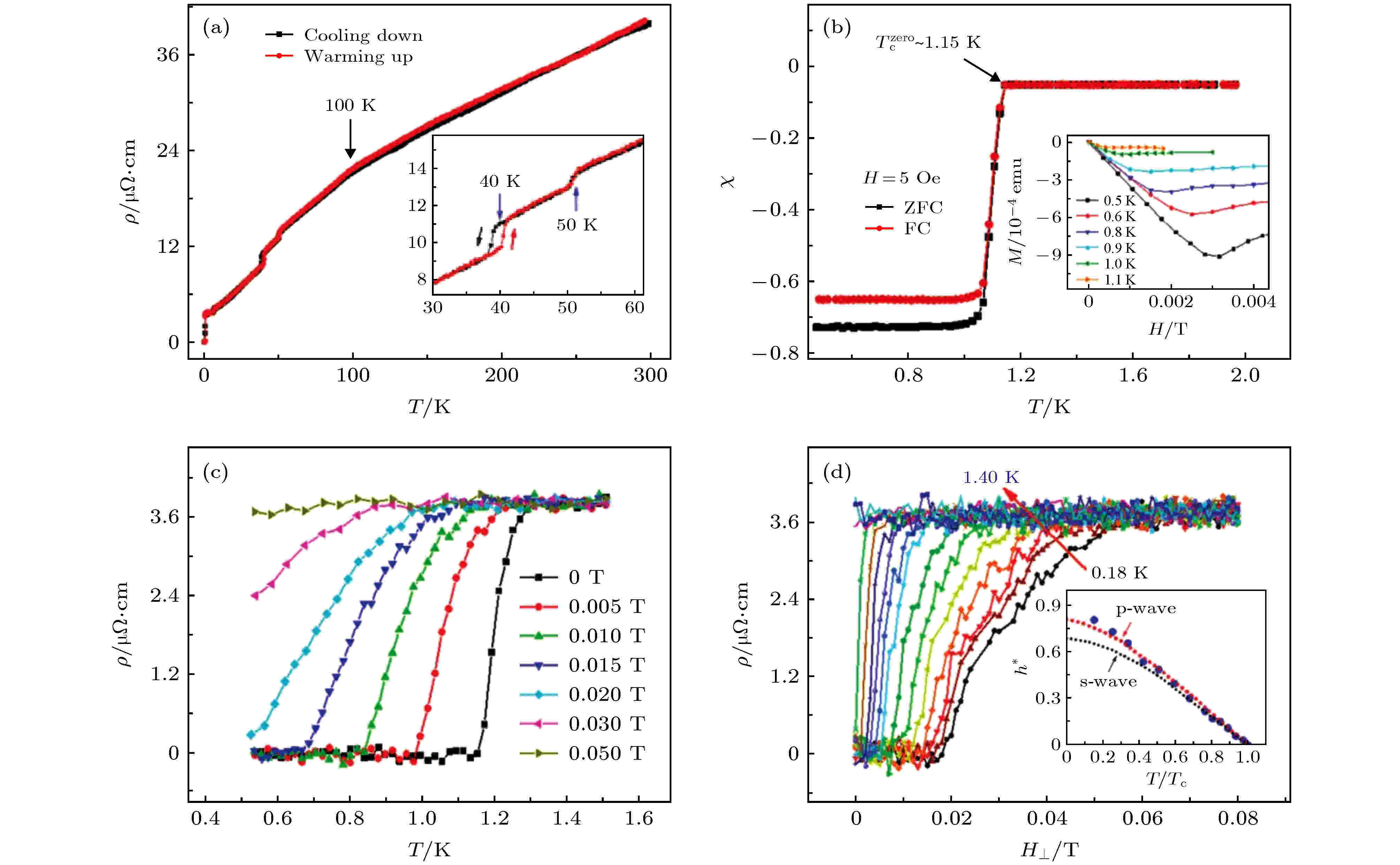
INVITED REVIEW
2020, 69 (2): 020301.
doi:10.7498/aps.69.20191627
Abstract +
In recent years, by introducing topological invariants into condensed matter systems, new phases of mater are revealed. Of these new phases, the topological insulator, topological semimetal and topological superconductor are the most important. They are called topological materials due to nontrivial topological parameters. Topological superconductors hold Majorana zero modes at the edges, satisfying non-abelian statistics, which makes them major candidate for realizing topological quantum computation. Besides exploring intrinsic topological superconductor, a promising way to realize topological superconductor is to induce superconductivity into other kinds of topological materials. Up to now, experimentalists have developed some techniques, such as gating, doping, high pressure, interface effect and hard point contact to introduce superconductivity into various topological materials, and also they have studied the topological properties of the induced superconductivity. In this review, we summarize the representative researches on intrinsic topological superconductor candidates and induced superconductivities in topological insulators and semimetals. The advantages and disadvantages of different techniques are discussed. Besides, the potential evidences of topological superconductors are analyzed. In the end, the outlook of this actively pursued research field is given.
REVIEWS
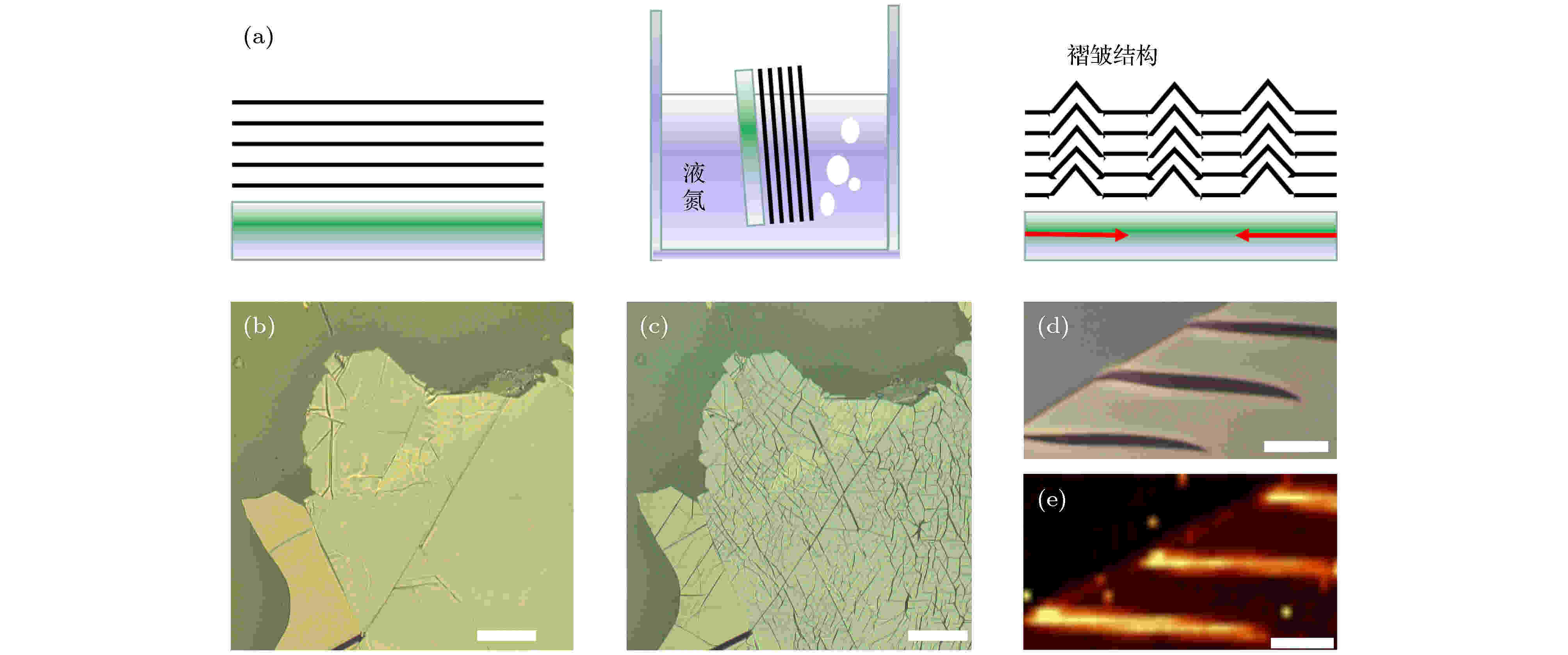
Inspiration of wrinkles in layered material for the mechanism study of several geological activities
2020, 69 (2): 026101.
doi:10.7498/aps.69.20190122
Abstract +
In this work, we propose a universal method of preparing wrinkle structures in layered crystals, which provides a good model for studying the physical properties of layered materials under strain. More importantly, there are some similarities between wrinkle engineering and geological activities, which inspires us to give some possible explanations to the mechanism for geological activities like earthquake and volcanic. The wrinkle structures of layered crystals can be achieved by exerting uniaxial or biaxial stress on the flexible substrate, which is very similar to the layered structure of the Earth and the formation of mountain folds on the Earth's surface. Since the Earth has an uneven mass distribution and self-rotation as well, the moments of inertia for plates are different from each other. Here in this work, we point out that there is a difference in angular velocity between the north hemisphere and south hemisphere, which may strongly influence the topography and geology activities near the equator. This work provides a possible mechanism explanation for several geological phenomena such as earthquakes, volcanoes, and continental drift. Based on China's special topography, we propose a matter flow hypothesis and discuss the orientation of matter flow in detail. We point out that the geological activity mechanism in China and the regions around plate boundaries is quite different. The matter flow hypothesis can be well applied to explain the causes of earthquake disasters in China, the distribution of mineral resources, and the possible causes of oil in the Middle East countries. Besides, it also provides a new theoretical guidance for predicting the earthquake disasters and prospecting the mineral resources in China. This work provides a new idea for humans to avoid natural disasters, to understand the natural phenomena on the Earth, and to make rational use of natural resources.
Original Articles
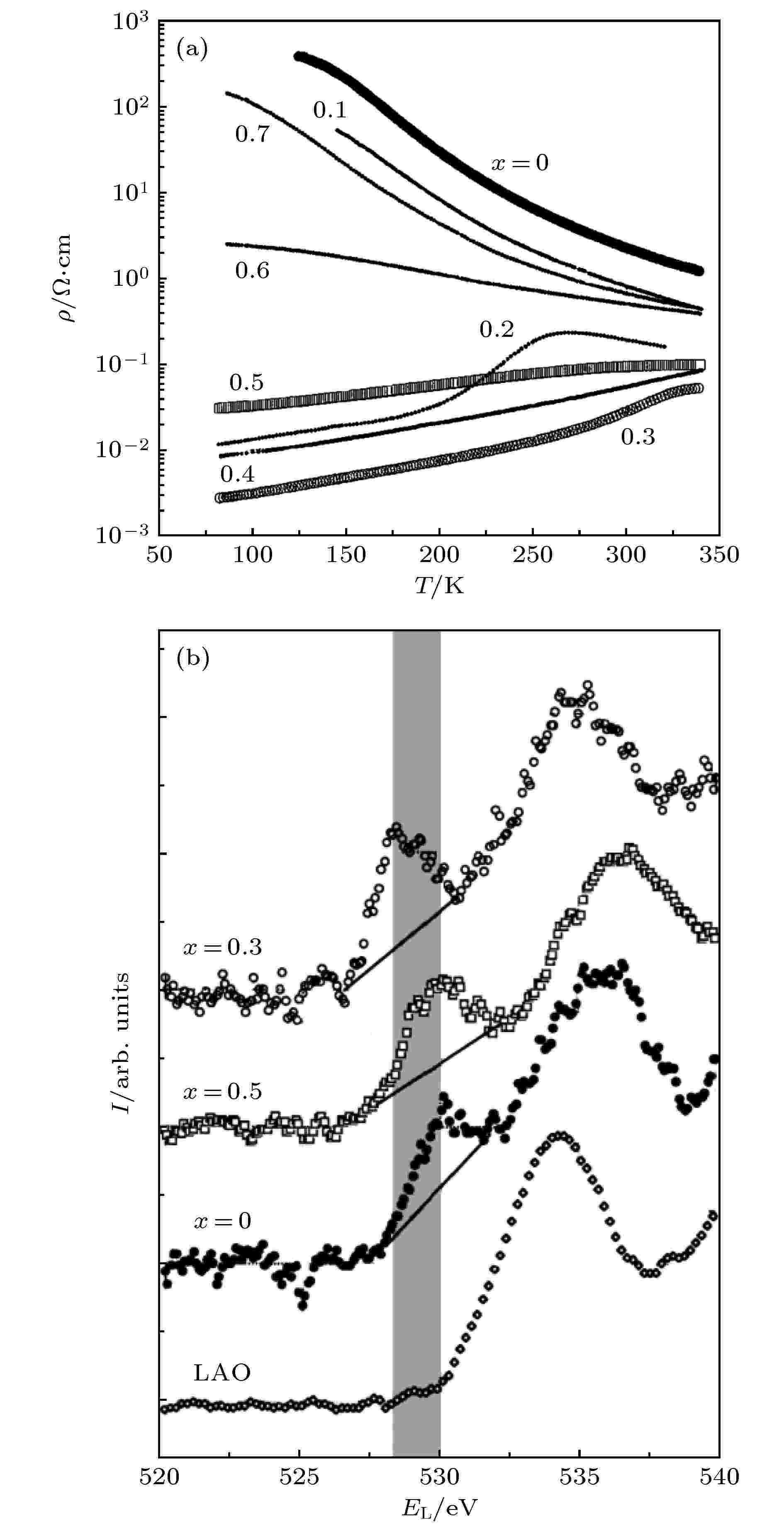
EDITOR'S SUGGESTION
2020, 69 (2): 027501.
doi:10.7498/aps.69.20191655
Abstract +
The conventional magnetic ordering models, exchange interaction, super-exchange (SE) interaction and double exchange (DE) interaction models relating to the valence electron structure in the materials, were proposed about in or before the 1950's, the time when there was little experimental evidence. Since the 1970's, more and more experimental results for the valence electron states have been reported. These experimental results suggested that the conventional magnetic ordering models need improving. i) Many experimental results, including the electron energy-loss spectra (EELS), X-ray absorption spectra (XAS), and X-ray photoelectron spectra (XPS), indicate that there are O–anions in addition to O2–anions in oxides, and that the percentage of O–anions may reach 30% or more. This suggests that the SE model and DE model both need to improving, in which all oxygen anions are assumed to be O2–anions. ii) Several experimental results, including gamma radiation diffraction, XAS and magnetic circular dichroism spectra (XMCD), suggest that part of 4s electrons enter into 3d orbits and transit into the 3d electrons in the process of forming metals from free atoms. The effect of the orbital magnetic moment on the magnetic moment of a bulk metal is far smaller than the spin magnetic moments. These provide the evidence of exploring the relation between magnetic moment and electrical resistivity of the magnetic metal. iii) Using density function theory (DFT) to fit physical properties yields plenty of results for many materials, but there exist serious difficulties for magnetic materials. This is due to magnetic ordering energy is included in the exchange correlation energy, which has been find no phenomenological expression so far, and has to be fitted using various models in DFT calculation. These investigations provide an opportunity to improve magnetic ordering models. Therefore, our group proposed three models of magnetic ordering in typical magnetic materials, they including an O 2p itinerant electron model for magnetic oxides (IEO model), a new itinerant electron model for magnetic metal (IEM model), and a Weiss electron pair (WEP) model for the origin of magnetic ordering energy. Replacing the SE model and DE model with the IEO model, the magnetic structures of Co, Ni, Cu doped spinel ferrites as well as Cr and Ti doped spinel ferrites can be explained. The dependence of the magnetic moment on the Sr content in perovskite manganites La1–xSrxMnO3can also be explained, for which there have been many ongoing disputes about the cation distributions. With the IEM model, we can explain qualitatively the relation of the magnetic moment with the resitivity for each of Fe, Co, Ni, Cu metals, and fit the curves of the resistivity of NiCu alloy versus test temperature and the Cu doped level. With the WEP model, we can explain why Fe, Co, Ni metal, NiCu alloys, Fe3O4and La0.7Sr0.3MnO3oxides have different Curie temperature values. The new itinerant electron model is different from the classical model in the following three elementary characteristics. First, the s electrons in free 3d transition metal atoms are divided into two parts when they form a metal or alloy. One part of these s electrons enter into the d orbits and change into the d electrons. and the other part of those electrons are the free electrons which are no longer called the s electrons. Second, only the d electrons occupying the outer orbit of an ion core in a metal or alloy may form itinerant electrons with a certain probability, while the remaining d electrons are local electrons. Third, whether in a magnetic metal or in a magnetic oxide, the transition of the itinerant electrons is the spin-dependent transition below the Curie temperature, and the transition probability decreases with test temperature increasing. The transition of the itinerant electrons turns into the spin-independent transition when the temperature is above the Curie temperature. In this paper, first, we introduce several typical experimental results of the valence electron states. Then, we present the new magnetic ordering models proposed by our group and analyze the elementary differences between the new models and the conventional models. Finally, we point out the challenge to the future work.
GENERAL
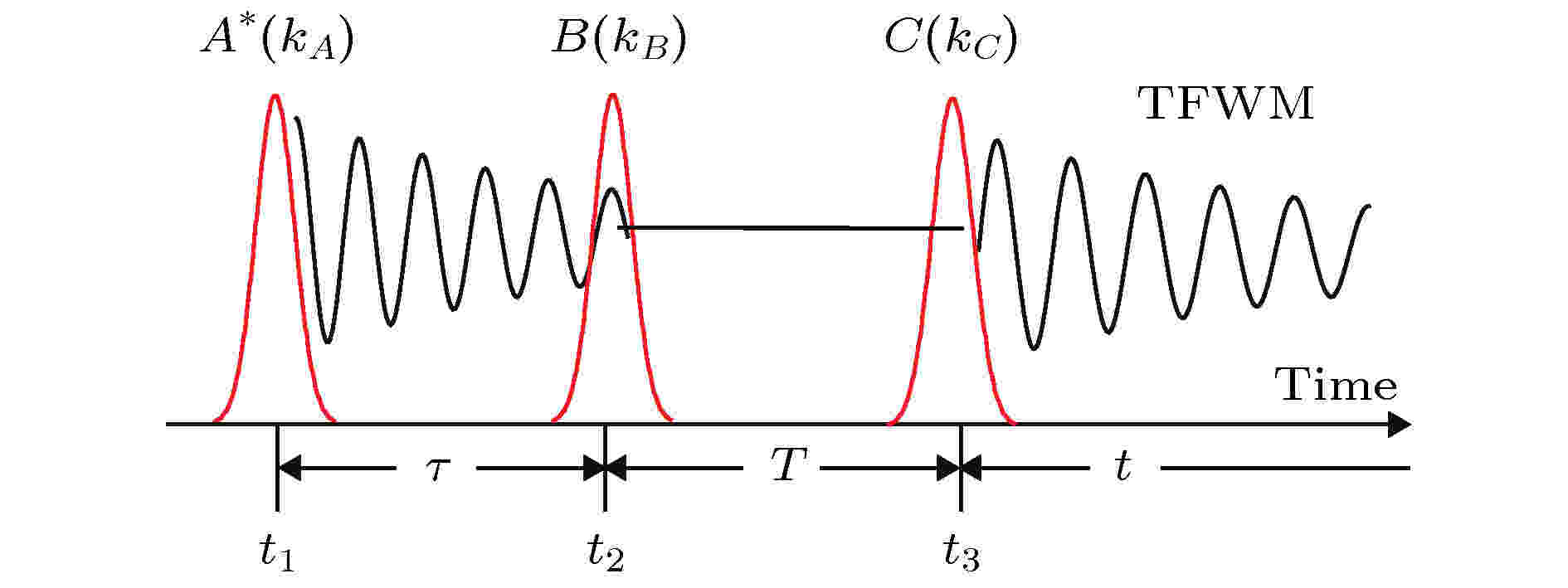
2020, 69 (2): 020201.
doi:10.7498/aps.69.20190964
Abstract +
With the development of laser technology in the field of optics, ultra-fast optics has become an important research field. Compared with the traditional technology, ultrafast optics can be realized not only under shorter pulse function, but also on a smaller scale, which can more quickly reflect the dynamic process. We present an analytical calculation of the full three-dimensional (3D) coherent spectrum with a finite duration two-dimensional (2D) Gaussian pulse envelope. Our starting point is the solution of the optical Bloch equations for three-level potassium atomic gas in the 3D time domain by using the projection-slice theorem, error function and Fourier-shift theorem of 3D Fourier transform. These principles are used to calculate and simplify the third-order polarization equation generated by the device, and the analytical calculation of three-dimensional Fourier transform frequency spectrum atT= 0 is obtained. We simulate the analytic solution by using mathematics software. By comparing the simulations with the experimental results, with the homogeneous line-width fixed, we can obtain the relationship among the in-homogeneous broadening, the correlation diagonal coefficients and the three-dimensional spectrum characteristics, which can be identified quantitatively by fitting the slices of three-dimensional Fourier transform spectrum peaks in an appropriate direction. The results show that the three-dimensional Fourier transform spectrum will extend along the diagonal direction with the increasing of the in-homogeneous broadening, and the spectrogram progressively becomes a circle with the increasing of the diagonal correlation coefficient, and the amplitude also gradually turns smaller. According to the analytical solution, we give a complete two-dimensional spectrum of theT= 0 interface. The results can be fit to the experimental 3D coherent spectrum for arbitrary inhomogeneity.
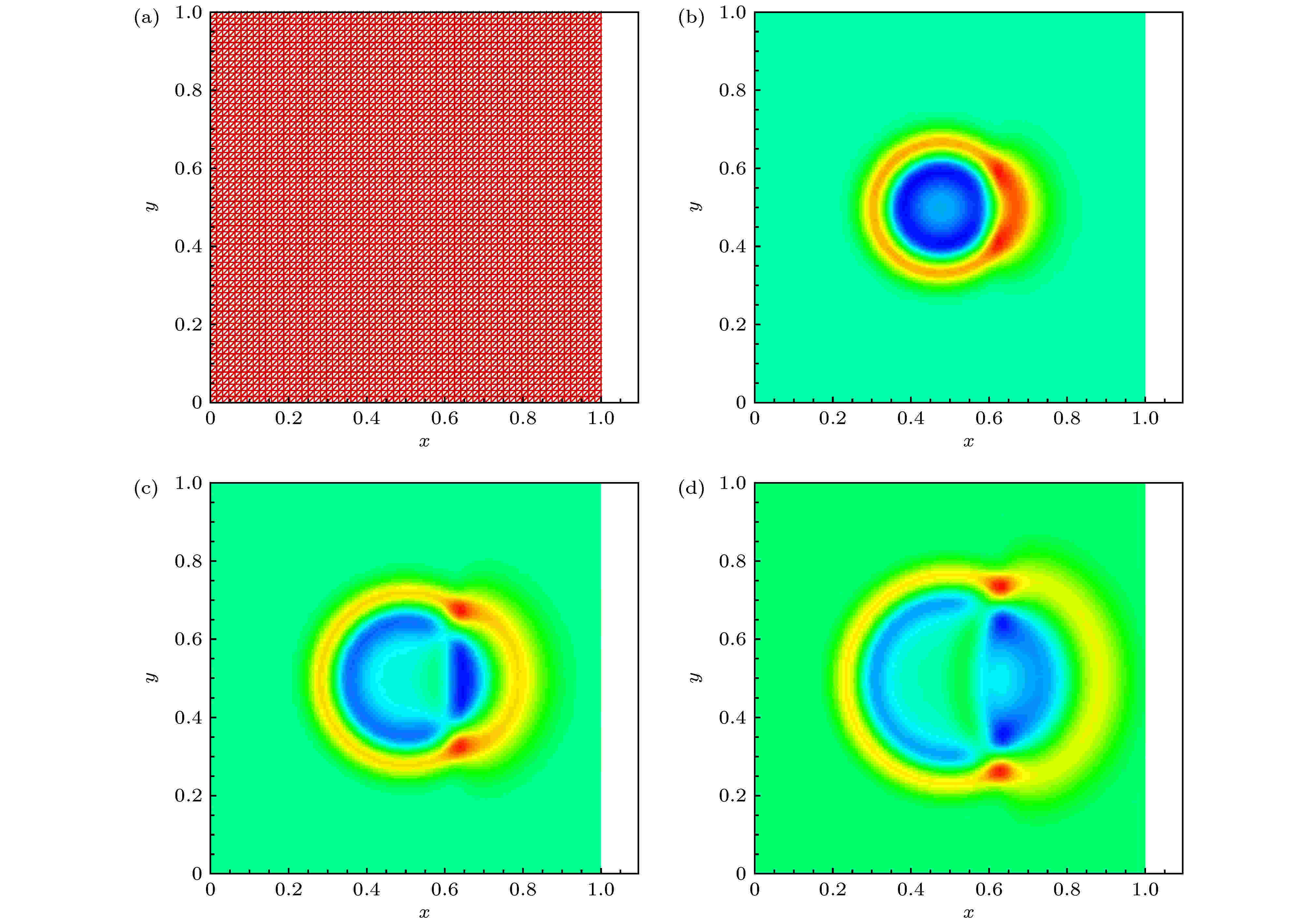
2020, 69 (2): 020202.
doi:10.7498/aps.69.20190613
Abstract +
The wave propagation is often carried out in complex geological structures. Solving the wave propagation problem effectively in inhomogeneous medium is of great interest and has many applications in physics and engineering. In this paper, the local discontinuous Galekin (LDG) method is applied to the numerical solution of the second-order wave equation. Firstly, the auxiliary variables are introduced, and the second-order wave equations are written as a system of first-order partial differential equations. Then the discontinuous Galerkin format is applied to the corresponding linearized wave equations and adjoint equations. We consider the triangulation in this paper. In order to ensure that the discrete format satisfies the energy conservation, the generalized alternating flux is chosen on the element boundary. We proves that the LDG method satisfies the energy conservation. The exponential integral factor method is used in time discretization. In order to improve the computational efficiency, the Krylov subspace method is used to approximate the product of the exponential matrix and the vector. Numerical examples with exact solutions are given in numerical experiments. The numerical results verify the numerical precision and energy conservation of the LDG method. In addition, the calculation of inhomogeneous medium and complex computational regions are considered. The results show that the LDG method is suitable for simulation of complex structures and propagation in multi-scale structured medium.
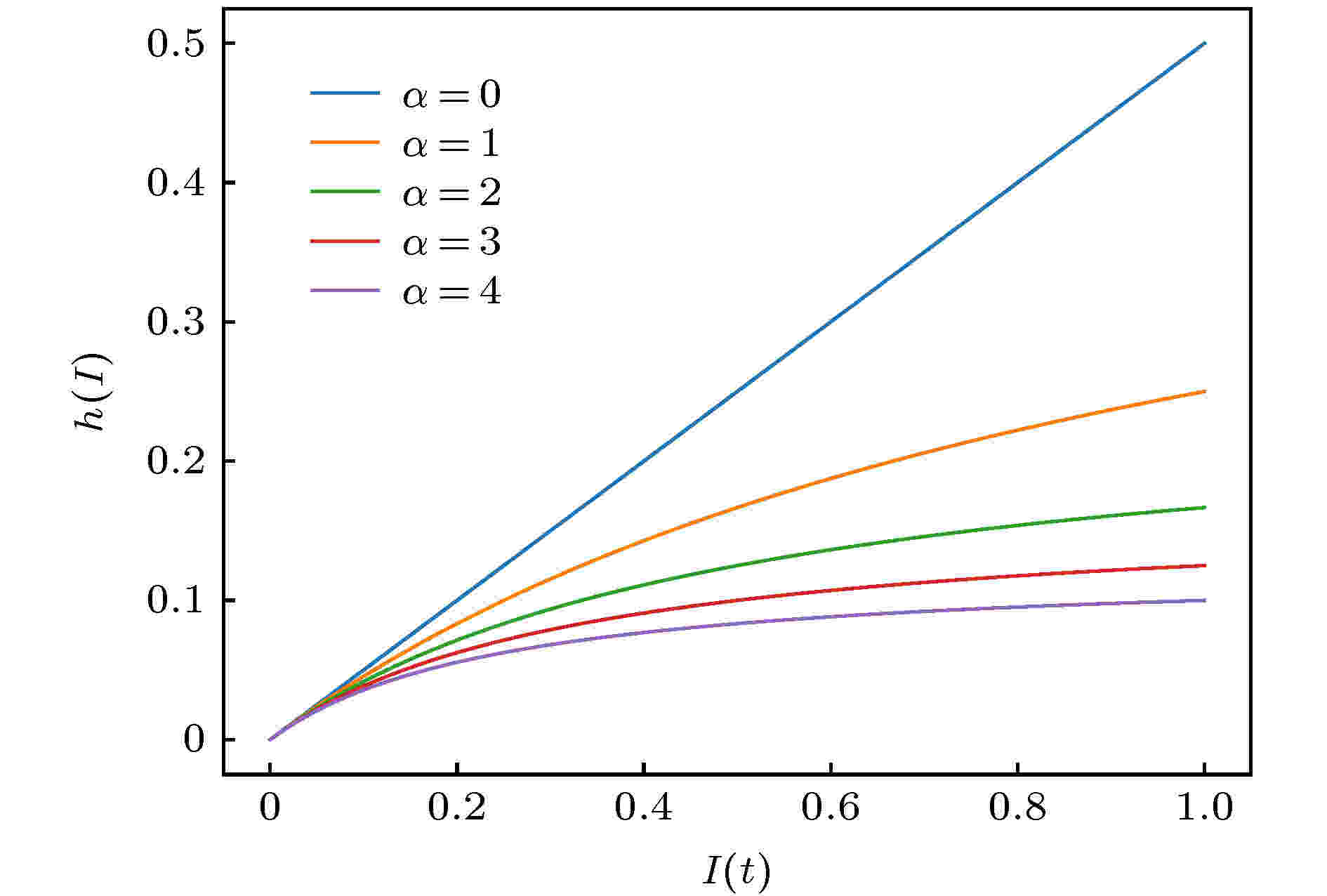
2020, 69 (2): 020501.
doi:10.7498/aps.69.20191503
Abstract +
In this paper, we establish a susceptible-infected-removed (SIR) rumor spreading model based on the influence of rumor-refuting mechanism and time delay on internet rumor spreading. The thresholdR0of rumor spreading is obtained by using the spectral radius method of regenerative matrix; the conditions for the existence of rumor prevailing equilibrium point are given according to the quadratic function characteristics; the local stability of rumor-free equilibrium point and rumor prevailing equilibrium point are established by using eigenvalue theory and Routh-Hurwitz criterion; and the criterion for the occurrence of Hopf bifurcation is also established. The numerical simulation results show that the information about refuting rumors, released by the government and the media, can accelerate the convergence rate of rumors and reduce the maximum density of rumor-spreaders.
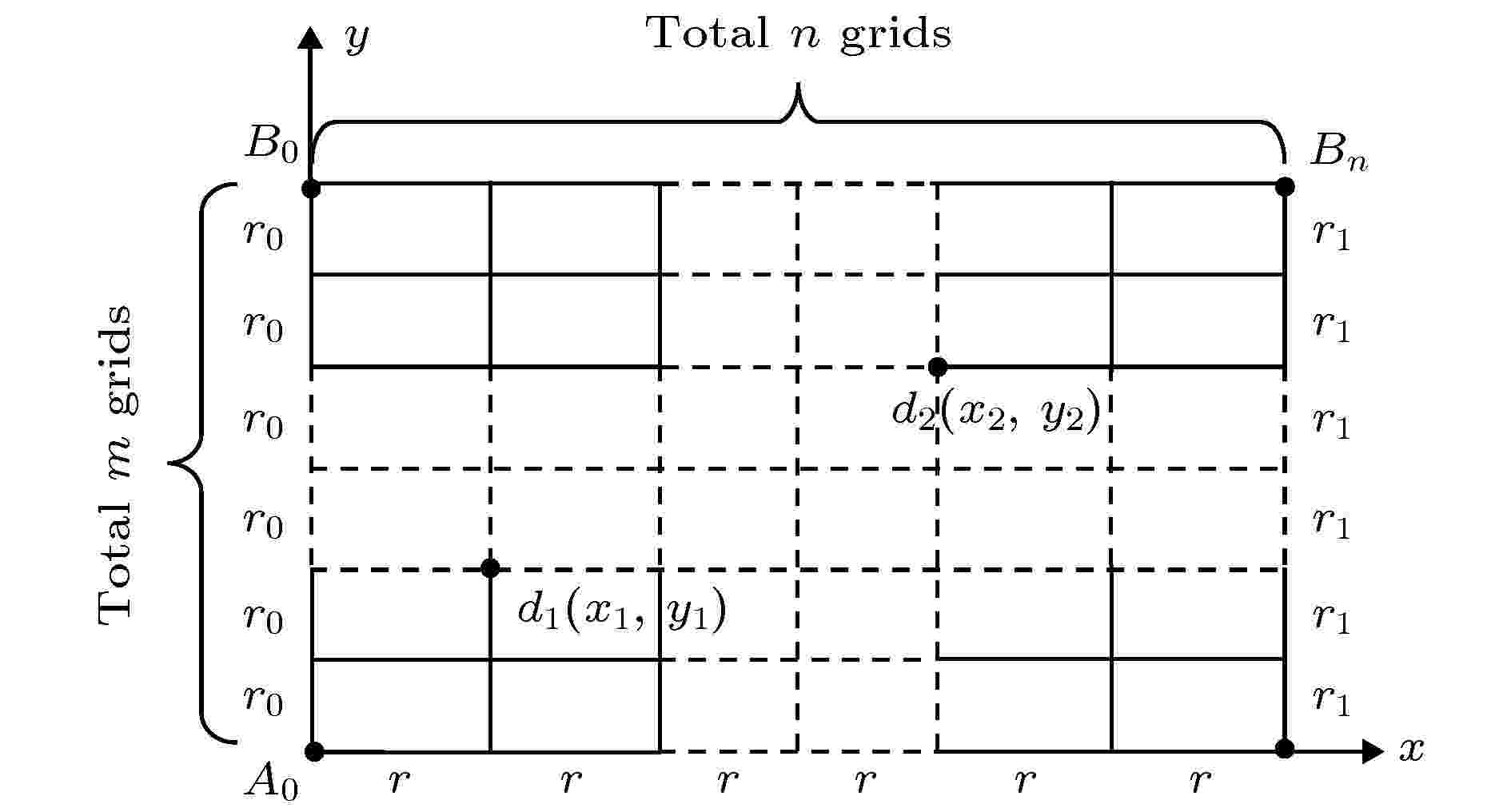
2020, 69 (2): 020502.
doi:10.7498/aps.69.20191303
Abstract +
ATOMIC AND MOLECULAR PHYSICS
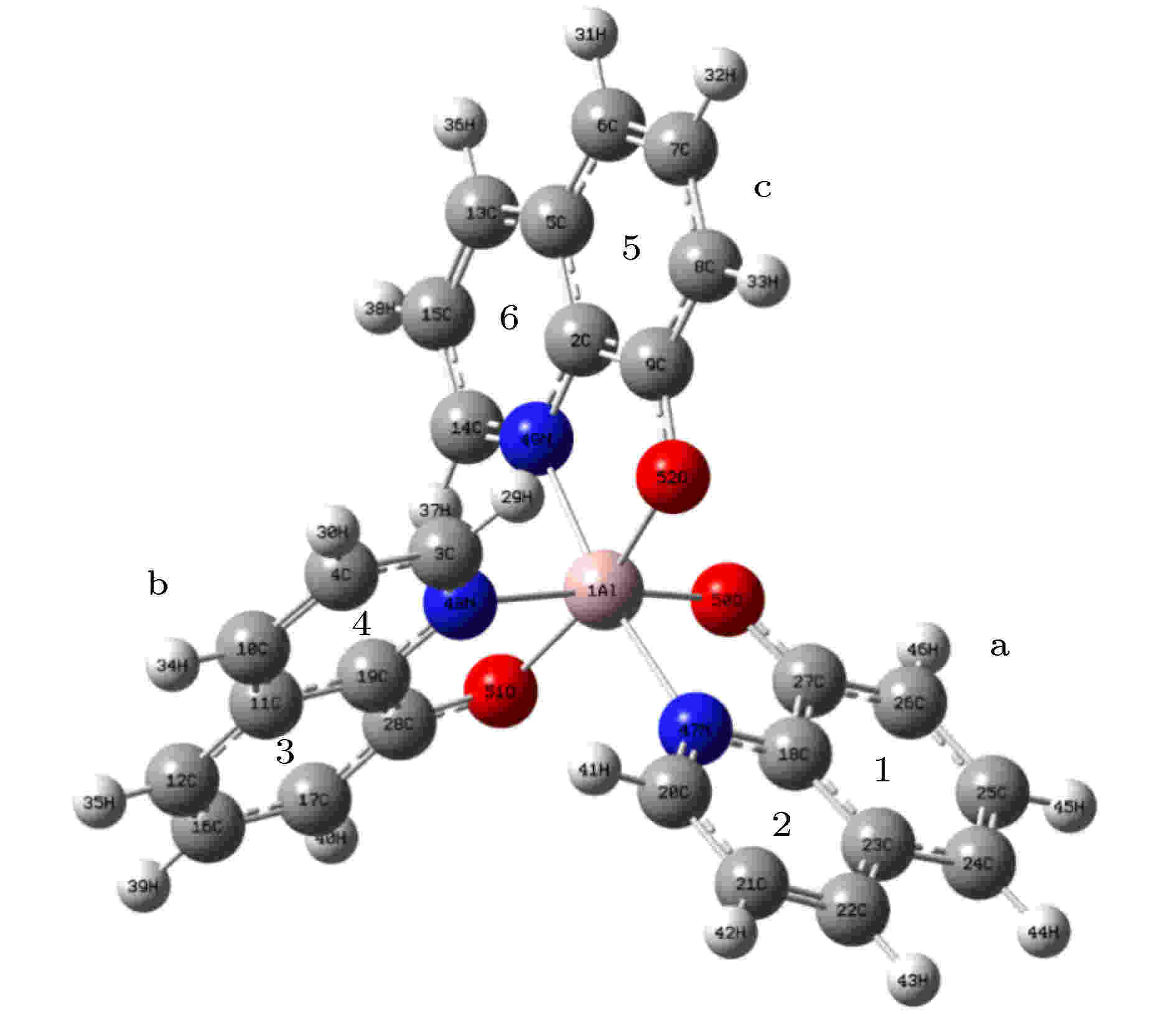
2020, 69 (2): 023101.
doi:10.7498/aps.69.20191453
Abstract +
Meridional tris(8-hydroxyquinoline)aluminum (III) (mer-Alq3) is an organometallic semiconductor material with phenomenal photo-electric properties. In order to understand the molecular luminescence properties of mer-Alq3, the density functional theoretical (B3LYP) method with 6-31G*basis set is employed to calculate its structure, infrared spectrum and Raman spectrum and the frontier molecular orbital of its ground state. The UV-vis absorption and the excited state characteristics are investigated by the time-dependent density functional theory (TD-DFT) method. The results show that the calculated spectral characteristics are in good agreement with the experimental data. The electron cloud of the highest occupied molecular orbital (HOMO) is located mostly on the phenoxide ring, whereas that of the lowest unoccupied molecular orbital (LUMO) sits on the pyridine ring. The absorption peaks of the UV-visible absorption spectrum are located in the visible and ultraviolet region. S0→S2 is attributed to the superposition of the π-π*local excitation in the direction from benzene ring to pyridine ring and the n-π*local excitation in the direction from oxygen atom to pyridine ring. The π-π*local excitation from benzene ring to pyridine ring is S0→S4. The superposition of π-n local excitation from benzene to carbon and n-n local excitation from oxygen to carbon are excited by S0→S11. S0→S14 is charge-transfer excitation and contributed by the superposition of π-π*in the direction from benzene ring to pyridine ring and n-π*in the direction from oxygen atom to pyridine ring. This work is significant for understanding the basic properties of mer-Alq3and the mechanisms of electron excitations. It provides a deeper insight into the luminescence mechanism of mer-Alq3, thus playing a guidance role in further improving the luminescence efficiency and regulating the spectral range of the light-emitting mer-Alq3.
ELECTROMAGNETISM, OPTICS, ACOUSTICS, HEAT TRANSFER, CLASSICAL MECHANICS, AND FLUID DYNAMICS
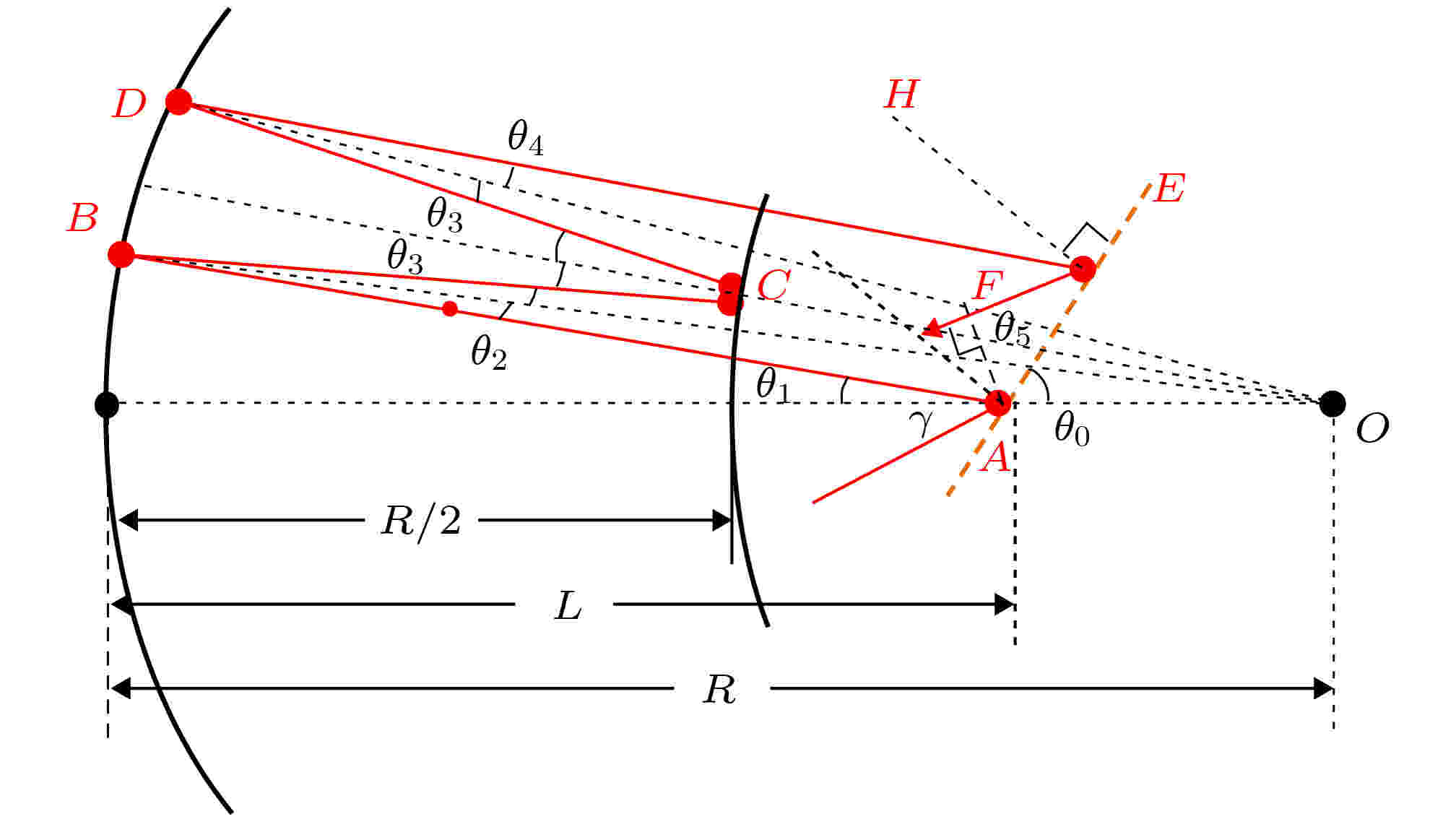
2020, 69 (2): 024201.
doi:10.7498/aps.69.20191587
Abstract +
Dispersion control is one of many key techniques in ultrashort laser pulse generation and its applications. By controlling the optical path of wavelength in the laser pulse to generate relative time delay, the pulse width of laser can be changed. The stretcher is the optical scheme to broaden the pulse width in chirp pulse amplification. By using ray trace, the pulse stretch time can be evaluated. However, due to the complicated formula of optical path in stretcher, it is difficult to obtain an analytical expression of high-order dispersion by using direct derivative. In this case, the present numerical methods are commonly used and error would be introduced into the optical system design and optimization inevitably. In this paper we introduce an analytical algorithm of stretcher dispersion. By summarizing the characteristic of stretcher formula, four fundamental functions are introduced to help to calculate the analytical derivative. By substituting the separate terms of the expressions step by step, analytical calculation of stretcher dispersion can be realized. In this paper, the ray trace of Martinez stretcher is first introduced to achieve similar phase expressions to them of existing Offner stretcher, then accurate high order dispersion results are attained by using analytical method, finally the calculation results by using the analytical method and numerical method are compared with each other. The algorithm introduced into this paper for calculating the dispersion is practical and hopeful in designing the chirp pulse amplification laser systems.

2020, 69 (2): 024202.
doi:10.7498/aps.69.20191351
Abstract +
The non-Hermitian description is of great significance for open systems, and the Hamiltonian which satisfies parity-time symmetry can make the energy have real eigenvalue within a certain range. The properties of parity-time symmetry have bright application prospects in optical systems. For semiconductor lasers, the parity-time symmetry can be constructed by adjusting the level of electrical injection to help achieve better mode control. Electric injection is easier to realize than optical pump when the device size is small and the structure is complex. Therefore, we hope to analyze the characteristics of the laser that satisfies the parity-time symmetry condition under the condition of electric injection. In this paper, we simulate the effects of different set loss values on parity-time symmetry. It is found that with the increase of set loss value, the imaginary part of the refractive index of the gain cavity corresponding to the parity-time symmetry breaking point so-called exceptional point will decrease, and the imaginary part of the characteristic frequency corresponding to the exceptional point will also decrease. We also simulate the effect of structural size ratio of gain region and loss region on parity-time symmetry. On condition that the total cavity length and the imaginary part of the refractive index of the loss region remain unchanged, as the gain cavity becomes longer and the loss cavity becomes shorter, the imaginary part of the refractive index of the gain cavity corresponding to the exceptional point will increase, and the imaginary part of the characteristic frequency corresponding to the exceptional point will also increase. And we qualitatively explain the above phenomenon through the coupled mode equations. Through experiments, metal organic chemical vapor deposition (MOCVD) and standard lithography techniques are used to fabricate asymmetric ridge lasers. Under thermoelectric cooler (TEC) refrigeration and by controlling the injection level of the gain area, the doubled mode spacing and halved mode number of ridge waveguide are found for the first time due to the parity-time symmetry breaking under the condition of electric injection. We believe that the study of parity-time symmetry in ridge laser under the condition of electric injection will be of great help in implementing the mode control.
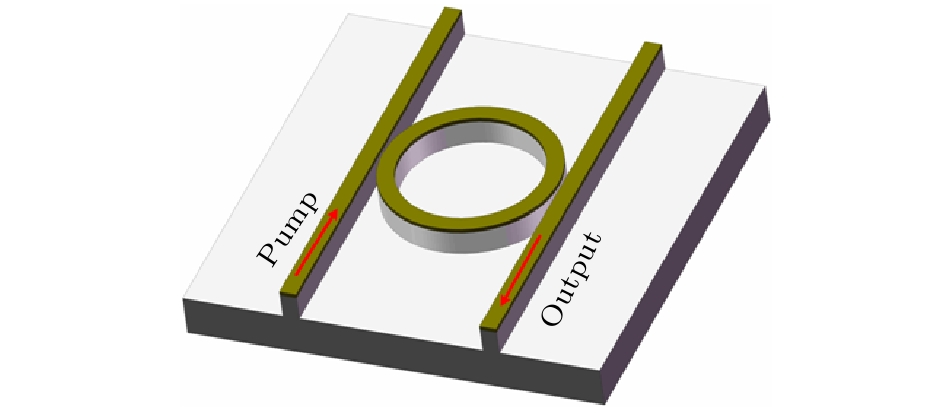
2020, 69 (2): 024203.
doi:10.7498/aps.69.20191294
Abstract +
With the consideration of the second and the third order nonlinear effect, the Lugiato-Lefeve equation which describes the field evolution of the fundamental frequency wave and the second harmonic wave is introduced. Based on the Lugiato-Lefeve equation, the generation of the second harmonic wave in the SiN microresonator is analyzed, and the effect of the each parameter on the dual field is studied. Simulation results indicate that the stable field of the fundamental frequency wave is of flat top pulse, and the field of the second harmonic wave is of sinusoidal distribution. When the detuning parameter increases, the power of the dual wave inside the microresonator oscillates, and the stable power weakens, the stable light field is periodically varied. Moreover, the chaos emerges as detuning parameter becomes large. The stable field can be generated in the microresonator with the weak pump power. However, because of the high pump power, the dispersion and nonlinear effect are enhanced, resulting in the periodic light field. Furthermore, the oscillation of the dual power curve is aggravated, as the pump power increases. In addition, the turning patterns can be observed by choosing the special dimension of microresonator. Theoretical analysis results are significant for studying the generation of the second harmonic wave in the microresonator.
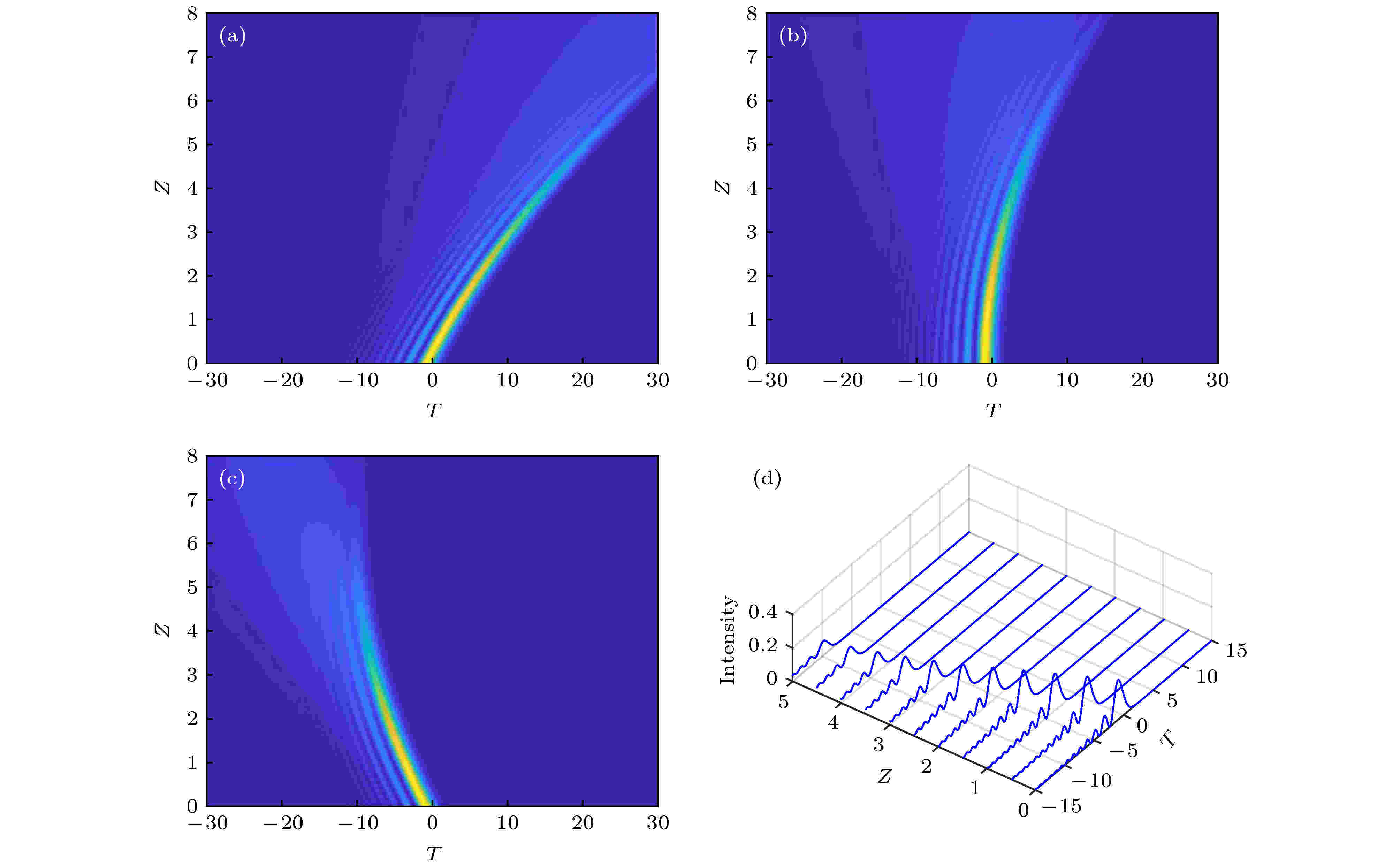
2020, 69 (2): 024204.
doi:10.7498/aps.69.20191272
Abstract +
Based on the (3+1)-dimensional free-space Schrödinger equation, the analytical solutions to the equation for the propagating properties of two three-dimensional collinear self-decelerating Airy-elegant-Laguerre-Gaussian(AELG) light beams in free space are investigated. The different mode numbers, the mode index for each of the collinear beams, weight factor of combined beam, and initial phase difference will affect the profiles of the wave packets, and thus giving the method to control the spatiotemporal profiles during propagation. The spatiotemporal profiles will rotate if none of the mode parameters are equal to zero, and there are vortices in the center of the phase distribution curve. If the mode parameters are positive numbers, the profiles of the beams will rotate in a helical clockwise direction. Otherwise, if the mode parameters are negative numbers,they will rotate in a helical anticlockwise direction during propagation. The wave packets will also rotate when the relative phase is varied. However, the rotation principles of these two rotation characteristics are completely different. The spatiotemporal hollow self-decelerating AELG wave packets can be attained if the mode numbers of the collinear AiELG wave packets are the same. Multi-ring structure evolves into single-ring structure along radial direction with their propagation distance increasing during propagation, which makes the hollow part expand continuously.
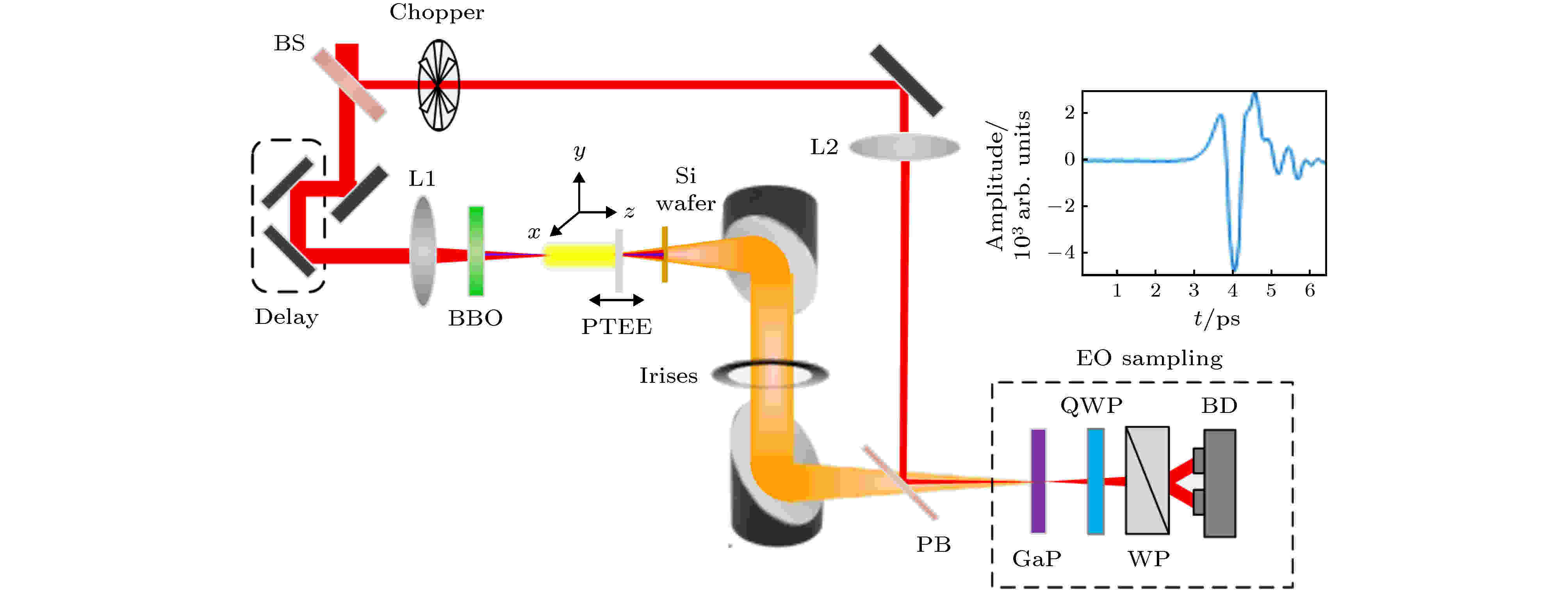
2020, 69 (2): 024205.
doi:10.7498/aps.69.20191200
Abstract +
Broadband terahertz (THz) emission generated from laser induced gas plasma provides an effective tool for studying nonlinear spectrum, imaging and remote sensing. Recently, the contribution of plasma oscillation to the THz emission was revealed from the nitrogen molecules pumped by intense two-color laser pulses. Plasma oscillation contributes only to the THz emission at relatively low plasma density due to negligible plasma absorption. More generally, with the THz emission generated from the ionizing gaseous medium, the surrounding plasma is expected to play an important role in the generation process. For the THz radiation from laser filament, the plasma region is extended in the laser propagation direction, and the effect of surrounding plasma on the emitted THz spectrum needs studying. In this work, we investigate the relation between pump power and filament length from THz spectrum emitted by air filament driven by two-color laser pulse. The time domain spectrum of THz field is recorded by an electro-optic (EO) sampling technique. In our experiments, significant frequency shifts are observed as the pump power and the filament length increase, and we find that the center frequency of the THz radiation is shifted towards longer wavelength, which is the so called red-shift of the THz spectrum. This red-shift is independent of THz radiation angle. The observations are explained by the plasma absorption inside the air filament. Our theoretical model is based on three mechanisms: the ionization-induced photocurrent, the plasma current oscillation and the plasma absorption. We coherently add up all the local THz fields inside the air filament, and simultaneously consider the plasma absorption induced correction of the THz spectrum. The simulation well reproduces the experimental observation. The skin depth decreases as the plasma density increases, thus the plasma absorption dominates the red-shift process. If the skin depth is larger than the filament length, the plasma oscillation contributes to the THz spectrum dominantly, and thus leading to the blue-shift of THz spectrum. Our results indicate that for the extended filament length or higher plasma density, the combining effect of photocurrent, plasma oscillation and absorption, results in the observed low-frequency broadband THz spectrum. Our study offers a method of coherently controlling the broadband THz spectrum.

2020, 69 (2): 024301.
doi:10.7498/aps.69.20191232
Abstract +
The accurate measurement of rain intensity and its distribution in vertical direction can not only help to understand the process of rainfall development, but also play an important role in human life such as agriculture, weather forecasting, water resources management, and natural disaster warning. According to the analysis of the geometric structure of earth-space link and propagation model of electromagnetic wave in atmosphere, in this paper we propose a method to reconstruct two-dimensional(2D) vertical rainfall field by using earth-space links. Firstly, the measured data of micro rain radar (MRR) from Nanjing are used to generate three real vertical rainfall fields which are marked as I, II and III respectively. Secondly, based on the analysis of the earth-space link’s geometry and the effect of signal attenuation from other factors such as scintillation, atmosphere gas and cloud, the vertical rainfall field inversion model is established. According to the power-law relationship between rain intensity and rain attenuation, which is given by International Telecommunication Union (ITU), the simultaneous algebraic reconstruction technique (SART) is used to inverse the vertical rainfall field. Then, one earth station which can receive a 17 GHz signal from satellite is employed to detect the vertical rainfall field. However, the simulation results show that it is difficult for one earth station to achieve the inversion of rainfall field, and that the correlation coefficients between rainfall fields and inversed fields are 0.556, 0.504 and 0.364 respectively. Based on the result, two earth stations are jointly used. In this simulation, the result shows that after 500 iterations the correlation coefficients all increase above 0.98, and the average biases between rainfall field I, II, III and their inversed fields are 0.122, 0.159 and 0.537 mm/h, respectively. Meanwhile, the Euclidean distances decrease to 0.246, 0.235 and 0.812 mm/h, and the relative errors of entropy are both less than 2%. It can be seen from the inversion fields that the vertical distribution of rain rate is close to that of the real field, which suggests that the method proposed in this paper can basically achieve the inversion of vertical rainfall field by using earth-space links. In addition, with the combined detection of three earth stations the accuracy of the inversion results is significantly improved. The correlation coefficients are all close to 1 and the mean deviations are all on the order of 10–12mm/h, indicating that the 2D vertical rainfall fields are accurately reconstructed. In the near future, the satellite constellation system will be globally deployed, which can promote the applications of our method in areas, such as plateaus, mountains and islands, where there exist no traditional observation data, serving as a supplement to existing precipitation measurements.

2020, 69 (2): 024302.
doi:10.7498/aps.69.20191454
Abstract +
The discovery of quantum Hall effect and quantum spin Hall effect has set off a new research upsurge in condensed matter physics. As is analogous to electronic systems, many novel optical and acoustic control devices have been designed by using the defects- immune and backscatter suppression of topological edges in photonic crystals and phononic crystals, which greatly enriches the current physical world and arouses more research enthusiasm. With the study of acoustic topological structure, it has been found that the realization of good reconfigurability, good compatibility against manufacturing defects, and compact acoustic topological insulators may become a promising development direction. This imposes higher requirements on the topological band gap width of the current acoustic topological structure. At the same time, the restriction on the using of the same primitive unit cells in previous researches does not reveal the implementation of aperiodic double Dirac cone topological insulators. Here in this work we present a tunable, two-dimensional broadband composite honeycomb lattice structure for airborne sound. Firstly, We construct a hexagonal structure and then take a circle with a radius ofr1in the center. Then the circle is anisotropically scaled with the scaling factors, which means that thexdirection of the circle is expanded by
$\sqrt s $
times, and the y direction is reduced by
$1/\sqrt s $
times to form an ellipse. Then, we perform a translation and rotation transformation on the ellipse, and finally construct a “triangular-like” petal pattern at each vertex of the hexagon. Secondly, we place a circle with a radius ofr2in the center to achieve the unit cell of the phononic crystal. This cell has two variables. One is the rotation angleθof the petal pattern around its centroid, and the other is the scaling factors. We find that there is a quadruple degenerate state atΓwiths= 1.2 andθ= ±33°. On both sides of ±33°, changingθwill induce an inverted band and a topological phase transition. At the same time, the relative band gap of the structure increases gradually. Whenθis 0° and 60°, the structures are two topologically distinct broadband phononic crystals with relative band widths of 0.39 and 0.33, respectively. Calculated by the finite element software Comsol, the edge states existing in the band gap are found, and the backscattering immunity characteristics of the topological edges to defects such as right angle, Z-angle, disorder, and cavity are confirmed. For the first time we construct a aperiodic double Dirac cone acoustic topological insulators with different values ofsand change their defect immunity. The research system is rich in function, and its relative bandwidth can even exceed 0.5 for a certainsvalue, which significantly exceeds the bandwidth of the known structure, and lays a good foundation for miniaturized acoustic wave devices taking full advantage of acoustic topological edges. Meanwhile, the realization of aperiodic topological insulators shows that the system can be used more flexibly for acoustic structure design.
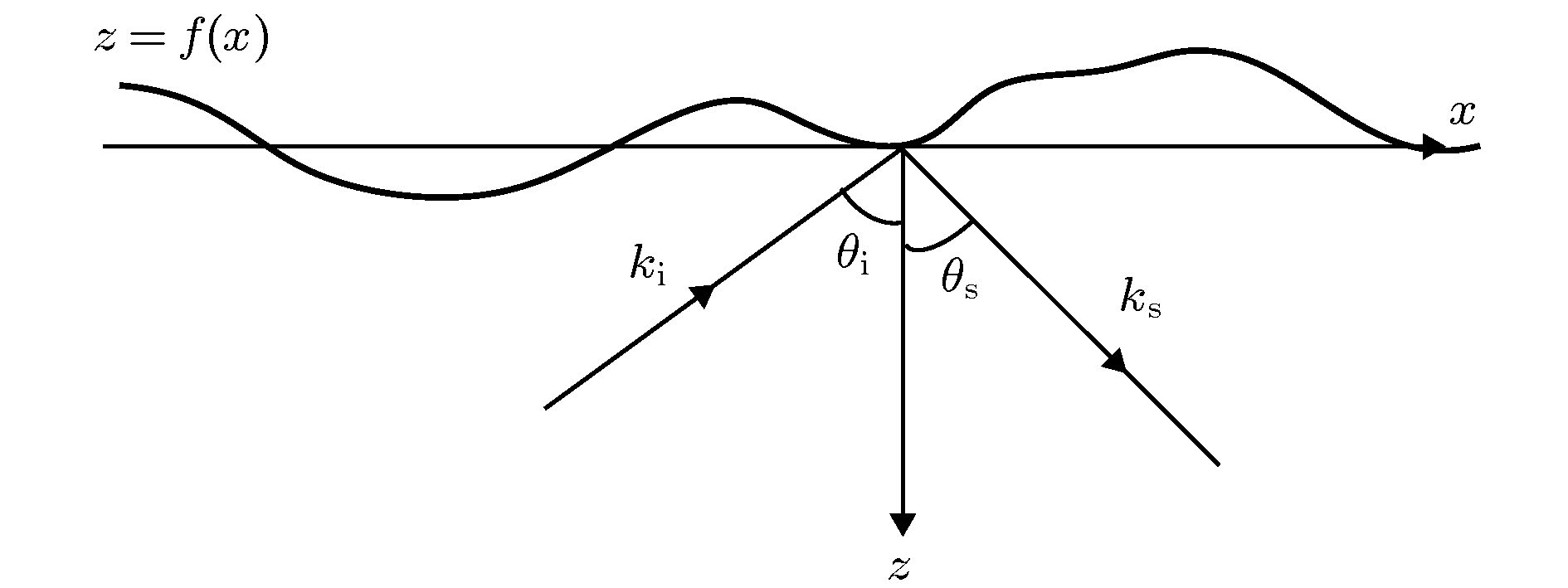
2020, 69 (2): 024303.
doi:10.7498/aps.69.20191208
Abstract +
The reflection coefficient of the flat sea surface in the ideal condition to the incident sound wave is –1. The perfect reflection effect does not introduce reflection loss. However, the sea surface is usually rough due to the wind. The wind-generated rough sea surface has not only reflection effect, but also scattering effect on the sound wave. At the same time, the wind-generated bubbles layer also has significant effect on the sound propagation. On the one hand, the bubbles layer can change the sound speed profile and result in the refraction of the incident sound wave. On the other hand, the bubbles layer has scattering effect and absorption effect on the incident sound wave and leads to the sound wave to attenuate. In fact, the rough sea surface and the bubbles layer are two main factors affecting the sound propagation in the windy weather at sea. Many researchers have paid much attention to the effect of the wind-generated rough sea surface on the sound propagation, but few of them have considered the effect of the wind-generated bubbles layer on the sound propagation. Based on the Ramsurf sound propagation model under the rough sea surface, the effects of wind-generated bubbles layer underneath rough sea surface on reflection loss and sound propagation with different wind speeds are analyzed. Based on the Hall-Novarini bubbles population model, the sound speed profile in the bubbles layer is modified and the attenuation coefficient due to scattering and absorption of the bubbles layer is calculated. The simulation results shows that when the wind speed is 10 m/s, the effect of the bubbles layer is significant on reflection loss with the frequencies higher than 2 kHz. In the given underwater acoustic environment, for a frequency of 3 kHz, when the source depth and the receiver depth are both 7 m, the enhancement of the transmission loss due to the bubbles layer is 2.6 dB for a wind speed of 13 m/s, and the enhancement is 8.1 dB for a wind speed of 16 m/s. And when the source depth and the receiver depth are both 18 m, the enhancement of the transmission loss due to the bubbles layer is 2.5 dB for a wind speed of 13 m/s and the enhancement is 4 dB for a wind speed of 16 m/s.
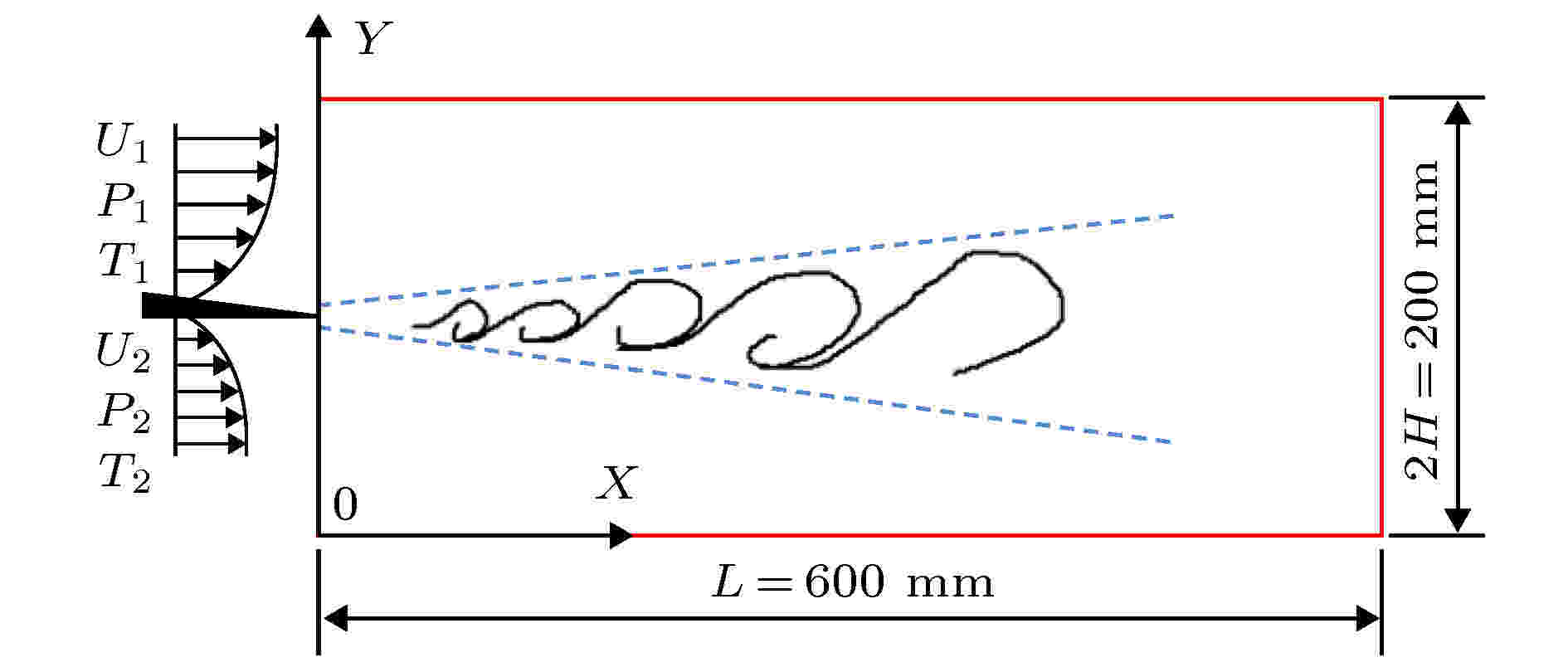
2020, 69 (2): 024701.
doi:10.7498/aps.69.20190681
Abstract +
By numerically solving the Navier-Stokes equations, the response characteristics of inflow-stimulated Kelvin-Helmholtz vortex in compressible shear layer arestudied. The mixing characteristics and the unique growth mechanism of the vortex structure are clearly revealed. By employing the index of vorticity thickness, the mixing properties are quantitatively analyzed. Based on the flow visualization results, the spatial size and the structure angle of the flow coherent structure are investigated by utilizing spatial correlation analysis. The evolution mechanism of the vortex structure in supersonic mixing layer induced by inlet forcing is revealed by analyzing the dynamical performances of the flow structure under different frequency disturbances. The numerical results show that with low forcing frequency atf= 5 kHz, the mixing efficiency is remarkably increased in the near-field of the flow. Whereas, in the far-field downstream the flow, the size of the structure reaches saturation state and the vortex passage frequency is locked, which causes the vorticity thickness to stabilize from 12mm to 14mm. Meanwhile, in a free mixing layer, the pairing and merging process occur in the flow field to promote the growth of the vortex structure, while in mixing layer with inlet forcing, the growth mechanism is that the vortex core engulfs a string of vortices induced by Kelvin-Helmholtz instability. The process of engulfment contributes much to the growth of the vortex structure. The analysis of spatial correlation distribution shows that in the area where engulfment occurs, the contour line shows the property of long and narrow ellipse instead of full ellipse and the structure in the area possesses the characteristics of intense rotation and inclination. Besides, with high inlet forcing frequency atf= 20 kHz, the size of the vortices becomes full in the near-field, and the vorticity thickness stabilizes between 3mm and 4 mm downstream the flow field. Meanwhile, the size of the vortex in controlled supersonic mixing layer is dominated by the imposed high-frequency forcing. An equation describing the quantitative relationship between the vortex characteristics and the imposed forcing frequency is derived, that is, the size of the uniform distribution vortex is approximately equal to the ratio of the value of convective velocity to inlet forcing frequency.
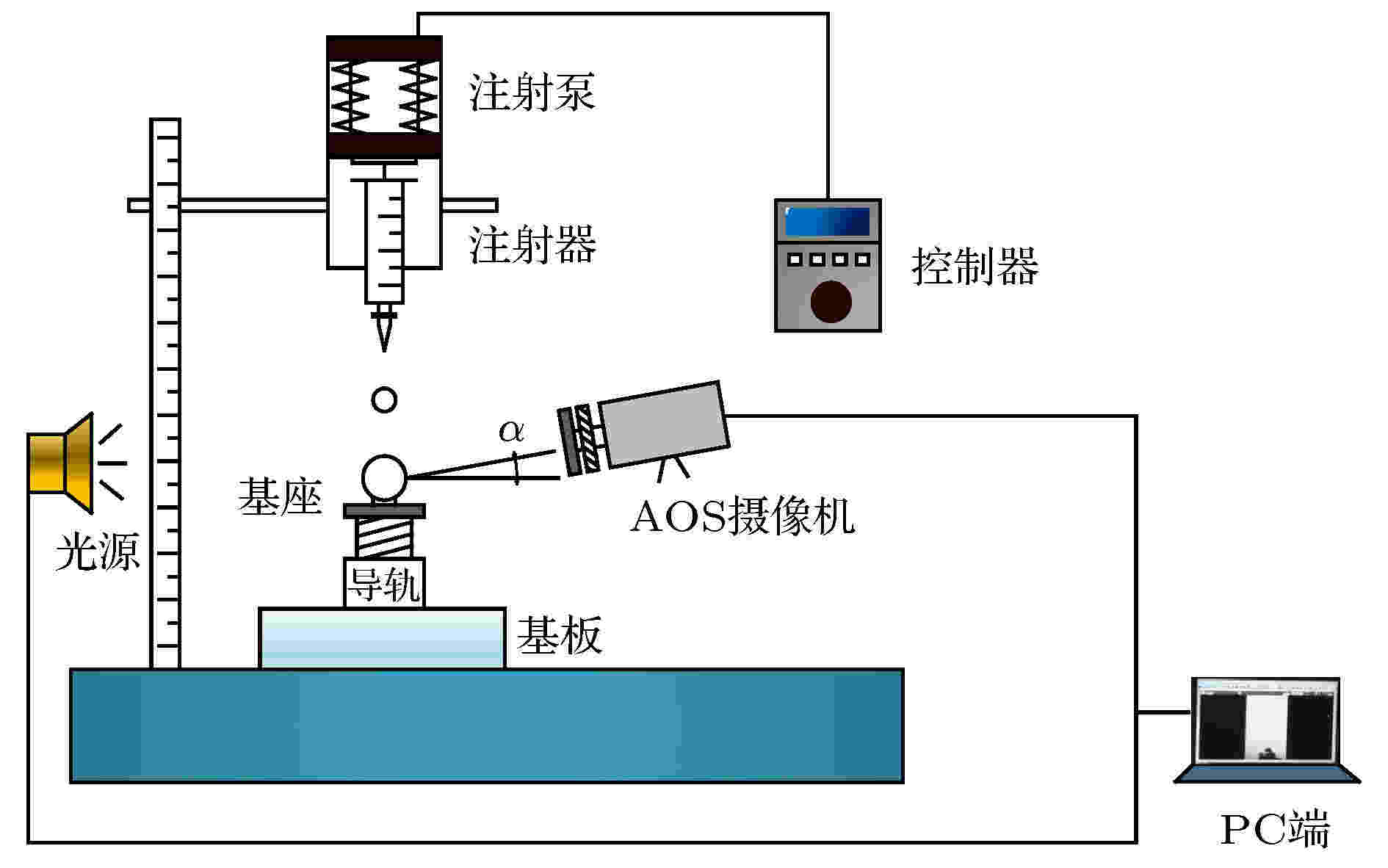
2020, 69 (2): 024702.
doi:10.7498/aps.69.20191141
Abstract +
The phenomenon that droplets impacting on the solid surface is ubiquitous in industrial applications such as spray cooling, spray painting, ink-jet printing, and fuel-air mixing internal combustion engines. The dynamic of droplet impacting on solid surface has been a hot topic in the area of fluid mechanics. Most of the existing experimental studies focused on the droplet impacting on flat or cylinder surface whereas the droplet impacting on a dry sphere surface, especially its effect from the sphere curvature, has been less investigated. Therefore, the dynamic behavior of a droplet impacting normally on a dry sphere is experimentally investigated at the relatively high Reynolds and Weber number in the present work. The impacting velocity of the droplet on the sphere is discussed with consideration of air resistance effect. The influences of spherical curvature and Weber number on the dynamic behavior and spreading factor are analyzed. The experimental results are compared with those of previous impacting flat researches. The results show that the drop velocity fluctuates significantly near the impacting sphere. The influence of the spherical curvature on the dynamic behavior of the droplet impact is obvious. The maximum spreading diameter of the liquid film will exceed that of the sphere with a curvature greater than 0.2 mm–1, and some segments of the liquid film rim even slide down directly. When the spherical curvature is less than 0.167 mm–1, the dynamic behaviors of the impacting droplet will undergo the spread, retraction, oscillation, and stable attachment after impacting. Then the maximum spreading factor of the droplet impacting sphere is little influenced by the curvature, and gradually tends to that of the droplet impacting plane with curvature decreasing. The Weber number has little influence on the spreading velocity of the liquid film, but obvious on the retraction. The maximum spreading factor gradually increases with Weber number increasing. A simple empirical correlation for the maximum spreading factor is obtained. This study conduces significantly to further investigating the dynamic characteristics of droplets impacting on the sphere.
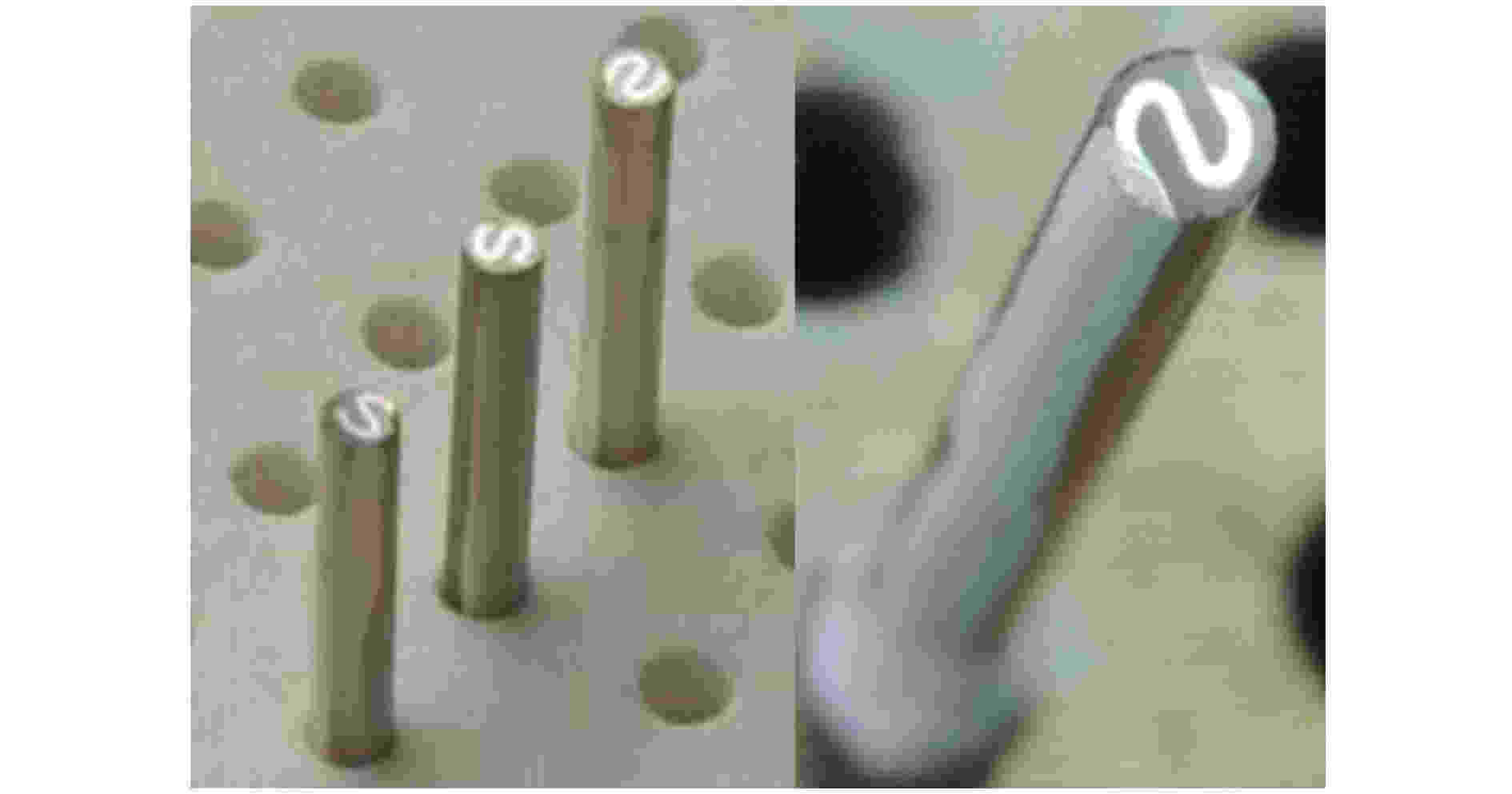
2020, 69 (2): 024703.
doi:10.7498/aps.69.20191155
Abstract +
Experiments are carried out on theΦ2 m Shock Tunnel (FD-14A) at the China Aerodynamics Research and Development Center to study the effect of the transverse groove with/without discharge hole on the hypersonic blunt flat-plate boundary layer transition, and the preliminary computational and theoretical research are carried out. The inflow Mach number of the test is 6, the unit Reynolds number is 3.3 × 107/m, the leading edge radius of the flat-plate is 1 mm, and the angle of attack is –4°. Three different sets of two-dimensional transverse grooves are arranged at 110 mm away from the leading edge of the flat-plate. The width and depth of the grooves are, respectively, 2.5 mm and 1 mm for groove 1, 3.75 mm and 1.5 mm for groove 2, and 5 mm and 2 mm for groove 3, at the same time, both ends of the groove 1 can open the discharge hole (the discharge hole has a size of 2.5 mm × 5.0 mm and a width the same as that of groove 1). The discharge hole is denoted as the groove 4, and the smooth flat-plate when the groove is not included is denoted as groove 5 or the flat. TheΦ2-mm-diameter cylindrical heat flux sensor is used to measure the heat flux distributions of the center line of the flat-plate under different conditions, and thus we can judge the transition of the boundary layer. The measurement results show that the smooth plate starts to transit atx≈ 340 mm, and the transition is nearly completed atx≈ 425 mm. The groove causes the transition position of the boundary layer of the plate to advance, and as the width and depth of the groove increase, the promoting effect on the transition is enhanced, and the transition position moves upstream. After the groove 1 is added to the discharge hole (groove 4), the heat flux distribution and the transition position are substantially the same as those of the smooth plate. After the boundary layer flow completely transits into turbulent flow, the difference in heat flux for each case is small, which indicates that the grooves of different specifications affect only the heat flux distribution in the transition process, but have little effect on the heat flux of the turbulent wall after the transition. The computational fluid dynamic results show that the discharge holes cause passive suction, and the test results show that the suction effect of the discharge holes at both ends of the groove counteracts the effect of the groove on the transition of the center line boundary layer, but it may be just a coincidence, and further research is needed. The linear stability theory (LST) and the optimal perturbation method are used to analyze the flow instability mechanism of the smooth blunt plate. The LST results show that there is no first mode instability nor second mode instability in the blunt plate flow. The modal instability mechanism cannot explain the observed transition in the test. The optimal disturbance calculation shows that the blunt plate flow suffers strong non-modal instability, which can qualitatively explain the observed transition phenomenon.
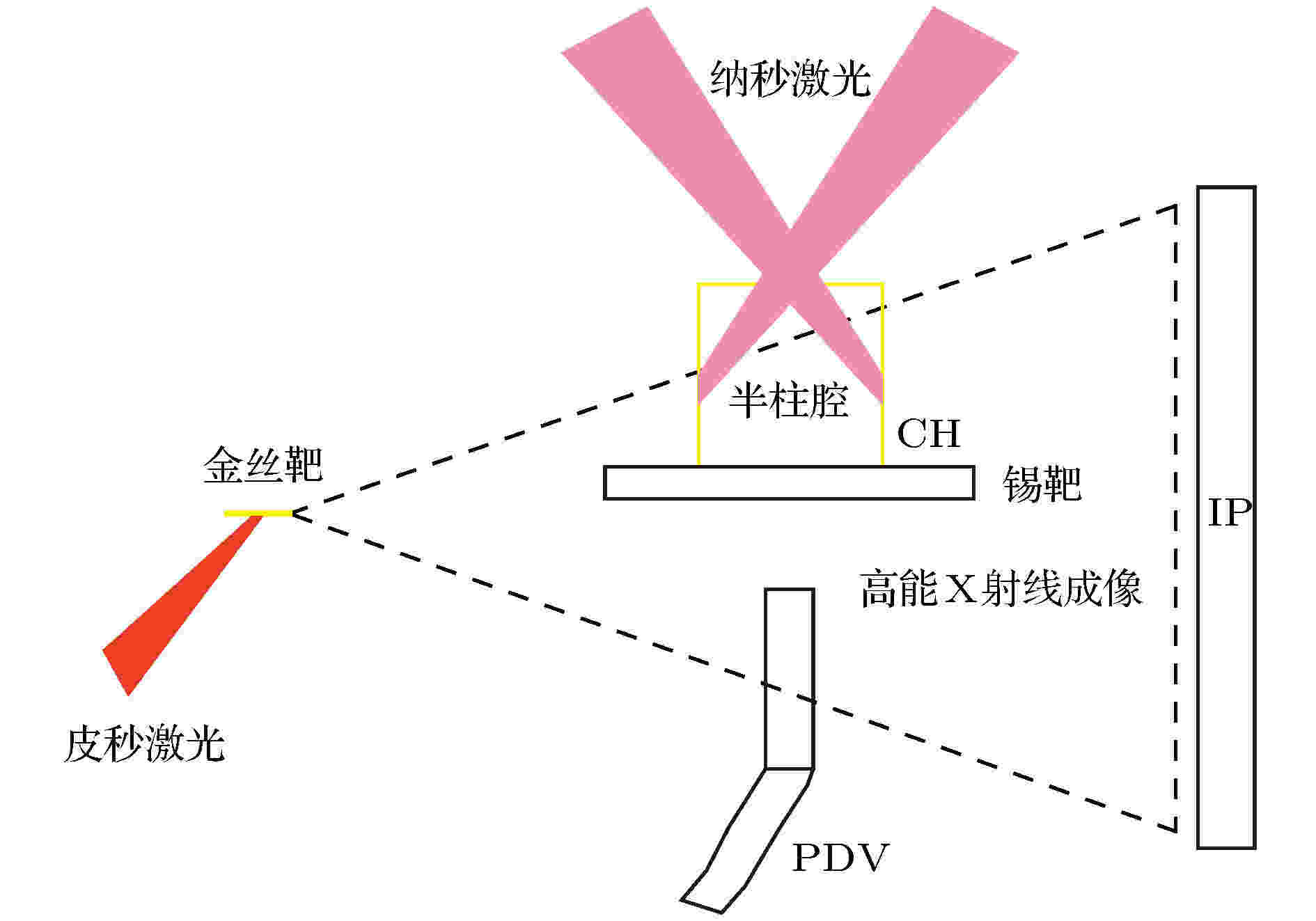
2020, 69 (2): 026201.
doi:10.7498/aps.69.20191245
Abstract +
High intensity laser is an efficient method for shock generator to study the dynamic fragmentation of materials, in which the direct drive is widely utilized. The continuum phase plate is used for smoothing the focal spot of the laser, but the loading region is usually smaller than the designed value. In this work, we study an experimental technique for investigating the dynamic fragmentation of metal via indirectly driving a high-intensity laser. Firstly, the radiation distributions on the sample for four different hohlraums each with a diameter of 2 mm but different length are simulated via the IRAD software, in which the proper hohlraum with a diameter of 2 mm and a height of 2 mm is selected for the experiments. Secondly, the peak temperatures and radiation waves under different laser energy and pulse durations are measured. The peak temperature decreases simultaneously as the laser energy decreases. In addition, the loading shock waves under a peak temperature of 140 eV and different radiation waves are estimated via the hydrodynamic simulation. It is revealed that a peak pressure of several tens of gigapascals is acquired and the peak pressure is greatly increased when the 10 μm CH layer is placed on the sample. In the end, the dynamic fragmentation process via indirect drive is investigated by using the high energy X-ray radiography and photonic Doppler velocimetry. The radiograph is a snapshot at 600 ns and shows a typical result of the spall process. The first layer is measured to be 0.06 mm thick and 0.3 mm away from the unperturbed free surface. It is also exhibited that the hohlraum is expanded to a large extent but is not broken up. The jump-up velocity and time of spall are measured to be 0.65 km/s and 131 ns, respectively. The average velocity of the first layer is estimated to be (0.63 ± 0.1) km/s, obtained via the distance of 0.3 mm divided by the time difference of 469 ns (600 ns minus 131 ns). The one-dimensional loading region is 2 mm, and the flatness is better than 5 %. This work provides a reference for designing new hohlraum, shock wave loading technique and dynamic fragmentation process.
PHYSICS OF GASES, PLASMAS, AND ELECTRIC DISCHARGES
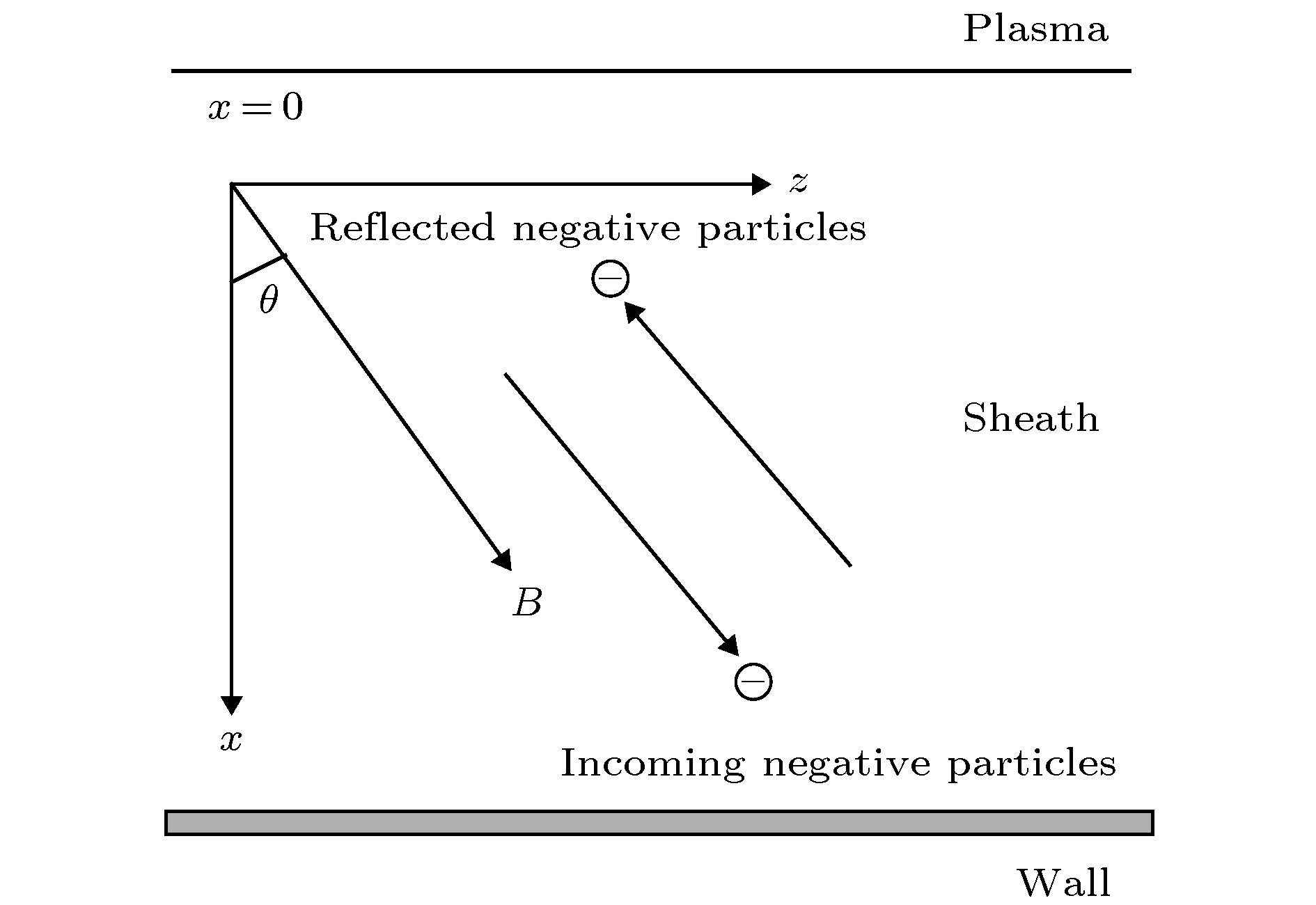
2020, 69 (2): 025201.
doi:10.7498/aps.69.20191307
Abstract +
The effects of the reflection of electrons and negative ions in magnetized electronegative and collisional plasma sheath on the Bohm criterion and the sheath structure are numerically investigated. The Bohm criterion expression of the sheath with considering the reflection of electrons and negative ions is derived theoretically. The lower limit of ion Mach number versus parameters and the distribution curve of charged particle density in sheath are obtained by numerical simulation when Boltzmannian model and reflection model are applied to electrons and negative ions. The results show that the upper limit of ion Mach number is identical to that of Boltzmannian model, but their lower limit expressions are different. The lower limit of ion Mach number in the reflection model is also related to the wall potential, and with the increase of the wall potential, ion Mach number first increases and then remains unchanged after reaching the same value as that from Boltzmannian model, and the speeds of their reaching the maximum values are different due to the difference in sheath edge negative ion concentration and temperature. In both Boltzmannian and the reflection model, the lower limit of the ion Mach number decreases with the concentration of the negative ion at the sheath edge increasing and the negative ion temperature decreasing, but the maximum value is smaller in the reflection model. The lower limit of ion Mach number for each of the two models increases with sheath edge electric field increasing, but increases faster and the final value is larger in Boltzmannian model. The lower limit of ion Mach number for each of the two models decreases with the increase of collision parameter or magnetic field angle, but decreases faster in Boltzmannian model with the increase of collision parameter or magnetic field angle. The lower limits of ion Mach number in the two models tend to be the same with the increase of magnetic field angle. When the wall potential is small, the reflection of electrons and negative ions has a great influence on the sheath structure. When the wall potential is large, the reflection of electrons and negative ions have little effect on the density distribution of charged particles in the sheath.
CONDENSED MATTER: STRUCTURAL, MECHANICAL, AND THERMAL PROPERTIES
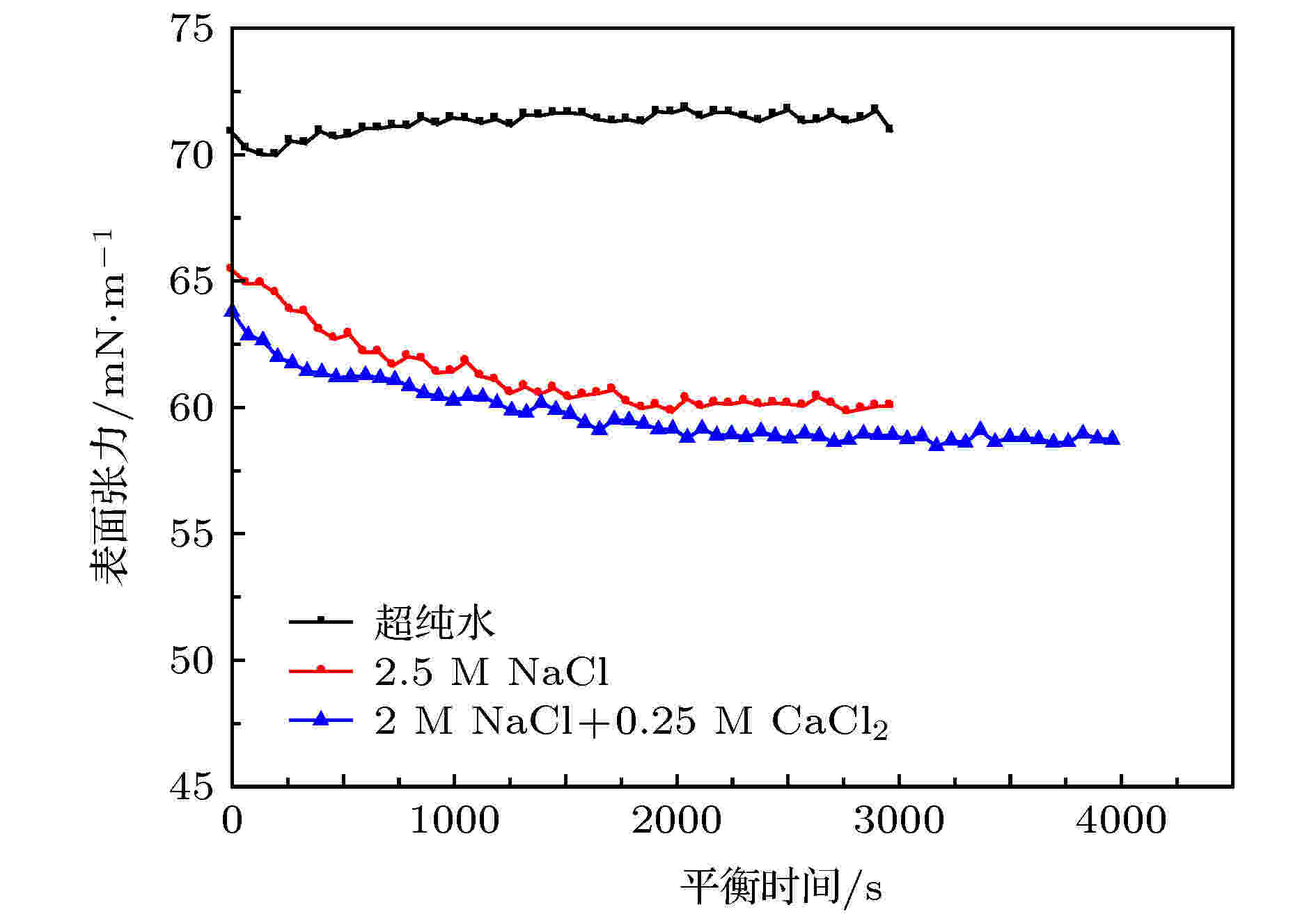
EDITOR'S SUGGESTION
2020, 69 (2): 026801.
doi:10.7498/aps.69.20190756
Abstract +
Silica nanoparticles (NPs) are more and more useful in many engineering areas, but the dynamic behaviors of adsorption of NPs at surface are not clear, especially when there exist surfactants on the surface. The modified NPs with the nonionic dimethyl silane are partially hydrophobic, and in this paper, the surface behavior is investigated which is determined by interfacial tension and surface compression modulus. It is concluded that the dimethyl silane coverage, the brine salinity and the surfactant would affect the NPs’ adsorption. Higher salinity in brine or higher dimethyl silane coverage causes lower steady state surface tension, which is related to the hydrophobicity and adsorption amount of NPs at the surface. When the cationic surfactant concentration is lower than critical micelle concentration (CMC), the surface tension of mixture system is a little bit higher than cationic surfactant’s. Cationic surfactant can be adsorbed at NPs’ surface to change the hydrophobicity based on the electrostatic attraction, and then some surfactants are dissolved in liquid phase together with NPs, while the anionic surfactant will not do so. In the shrinking droplet process, the surface tension of the NPs with 1.5 μmol/m2dimethyl silane decreases from ~59 mN/m at the steady state to ~50 mN/m, which proves that the NPs’ adsorption density can be higher even after infinite long time equilibrium due to the repulsive force between the NPs. Besides, the curve of interfacial tension (IFT) versus surface area shows three parts with different declining slopes. In the first part, the relatively low adsorption of NPs at the surface means weak interaction between NPs. Then in the second part, due to the irreversible adsorption, the spacing between NPs decreases with adsorption amount increasing and surface area lowering, so the increasing of NPs’ interaction leads to high surface compression modulus. After that, the IFT curve keeps flat since the NPs assembly reaches to the closest peck. With the increase of NPs’ hydrophobicity, the compression modulus increases up to ~70 mN/m, which satisfies the Gibbs criterion to resist coarsening of the foam or emulsion. However, for the mixing system, increasing surfactant concentration leads to a lower surface tension at steady state, then the surface tension difference or compression modulus decreases too. Finally, we find that the compression modulus order from high to low is as follows: NPs, cationic surfactant-NPs, anionic surfactant-NPs, surfactants. This investigation is meaningful for accounting for the enhancement of foam or emulsion stability with NPs affected by salinity and surfactant.
CONDENSED MATTER: ELECTRONIC STRUCTURE, ELECTRICAL, MAGNETIC, AND OPTICAL PROPERTIES
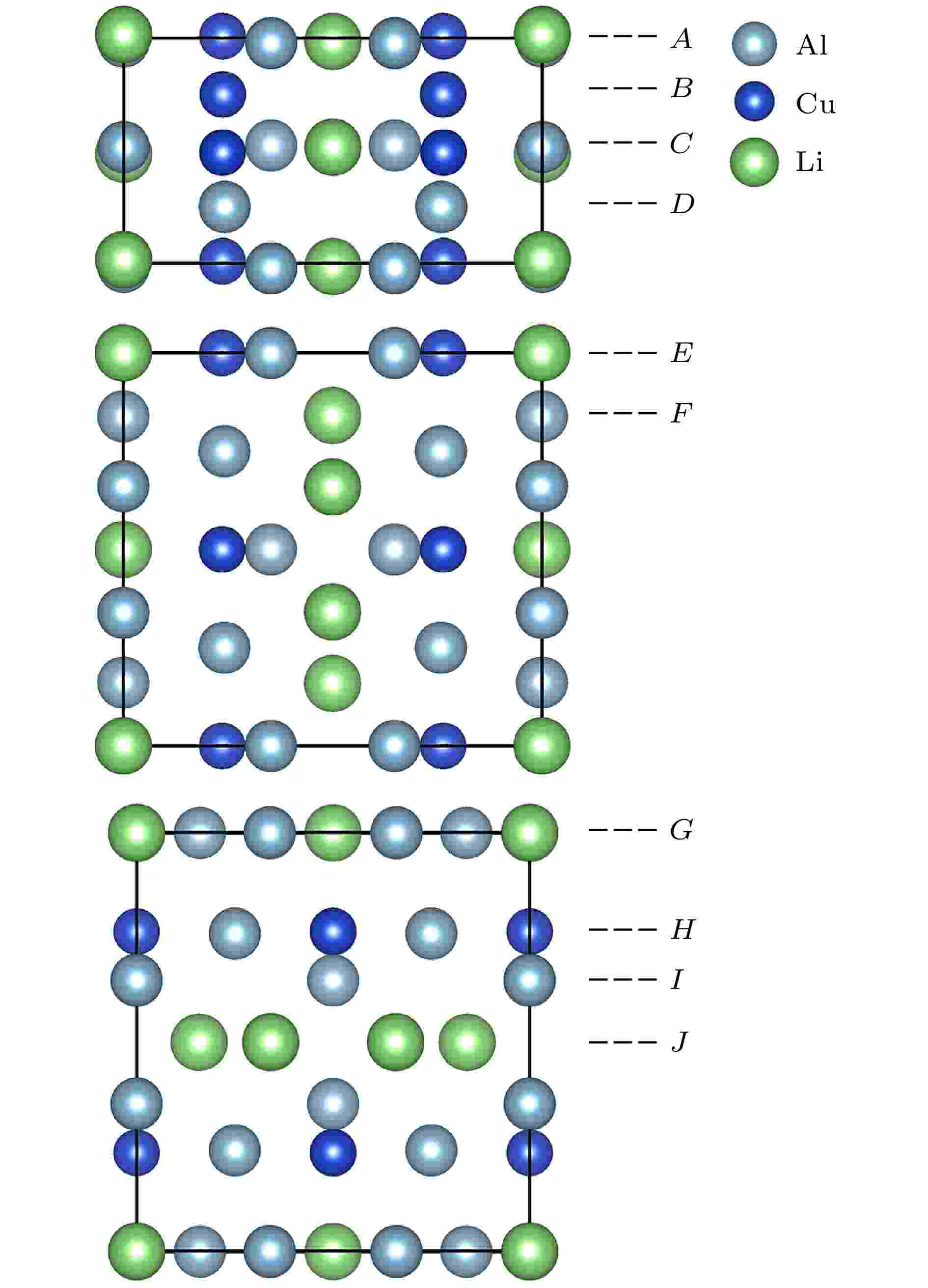
2020, 69 (2): 027101.
doi:10.7498/aps.69.20191365
Abstract +
First principle calculations in the framework of density functional theory are performed to calculate the T1 phase (Al6Cu4Li3), which is the main precipitation in Al-Cu-Li alloy. In this paper, the surface energy values and surface electron work functions of different termination surfaces in T1 phase are calculated. Meanwhile, the effects of stress and common alloying elements on the T1 phase are also discussed. There are 10 different termination surfaces for T1 phase. The surface energy varies between 0.59 and 1.28 J·m–2. It is found that the surface energy is dependent on the atomic configuration of the surface. The relaxation of the surficial atoms leads to low surface energy. For work function, it is controlled by the surficial atomic species. When a surface contains Li atoms, low work function is expected, which can be attributed to the low electronegativity of Li atom. The (010) T1 surface with Li termination has a minimum work function, 3.40 eV. In addition, as is different from pure metal, work function of some T1 surfaces shows unique behavior under stress state. The (010) T1 surface with Al and Cu termination has an increasing work function under the action of tensile strain. In fact, tensile strain induces the first and second surface layer to merge, which can improve the surface electronic density and raise work function. As a result, the corrosion resistance can be enhanced. Finally, the effect of alloying elements on the precipitation of T1 phase is studied. Al(111)/T1(010) interface is built and the substitution energy of Mg, Zn and Ag are calculated. Comparing with Mg and Zn atom, the energy of Ag atom to substitute the interfacial one is low, meaning that Ag can relax the strain in the interface. Ag atom has the closest atomic radius to Al atom, and the same chemical valence as Li atom. Therefore, Ag atom is more likely to promote the precipitation of T1 phase, which is also in agreement with the experimental result.

2020, 69 (2): 027801.
doi:10.7498/aps.69.20191511
Abstract +
The metamaterial absorber has the advantages of thin thickness, small size, simple structure and high absorption. As is different from the traditional metamaterial absorber, the adjustable material is used for designing the structure, which can realize the dynamic modulation of the device by changing the external factors without changing the device structure. In this paper, an adjustable terahertz absorber with multi-defect combination embedded VO2thin film is proposed. It is composed of three layers: the upper metal pattern layer, the substrate and the bottom metal plate. Vanadium dioxide medium is sandwiched between the upper surface and the substrate. The absorption performance of the absorber composed of different defect combinations is studied, and the electric field distribution of each combination is analyzed. At the same time, the influences of defects on the absorption performance of the absorber are compared with each other and analyzed. After comprehensive analysis, the defects are combined into the final proposed structure, and the electric field distribution and surface current distribution are analyzed. The relevant parameters affecting the performance of the absorber are scanned and analyzed, and the final optimized structural parameters are obtained. The results show that the absorption rate atf= 4.08 THz andf= 4.33 THz are 99.8% and 99.9%, respectively. The phase transition of vanadium dioxide can be controlled by changing ambient temperature, so that the absorption rates of two frequency points can be changed from 99.8% to 1.0%. In addition, the surface normalized impedance of the proposed absorber is analyzed, which shows that the normalized surface impedance of the designed absorber matches the impedance of the free space well. By changing the incident angle and polarization of terahertz wave, the results show that the absorption rate of the absorber under TE and TM polarization wave both can be more than 98% with the incident angle ranging from 0° to 40°. The proposed terahertz wave absorber has the characteristics of high absorption, dynamic tuning and insensitive polarization. It has good application prospects in terahertz wave related fields such as detectors and stealth technology.

2020, 69 (2): 027802.
doi:10.7498/aps.69.20191418
Abstract +
Compared with conventional light-emitting diode (LED), micro-LED has excellent photo-electric properties such as high current density, light output power density, light response frequency. It has widespread application prospects in the field of light display, optical tweezers, and visible light communication. However, dry etching inevitably leads the sidewall to be damaged, which results in the degradation of device properties. In this letter, a micro-LED array device based on F ions implantation isolation technology is presented to avoid damaging the sidewall. We systemically investigate the influence of fluorine ion implantation energy and light-emitting apertures on the photoelectric properties of the micro-LED array device by testing the current-voltage characteristic and light output power. The investigation results show that comparing with F ion 50 keV single implantation device, the reverse leakage of 50/100 keV double implantation device decreases by 8.4 times and the optical output density increases by 1.3 times. When the light-emitting apertures are different (6, 8, 10 μm respectively), the reverse leakage current remains constant, and the forward operating voltage decreasesfrom 3.3 V to 3.1 V and to 2.9 V with the increase of the aperture. Besides, the available area ratio, i.e. the ratio of actual light-emitting area to device area of single micro-LED with different light-emitting apertures are 85%, 87%, and 92%, respectively. The electrical isolation of the micro-LED array is realized by ion implantation isolation technology, and the micro-LED has some advantages over the conventional mesa etching micro-LED device, such as low reverse leakage current density, high optical output power density, and high effective light-emitting area ratio.
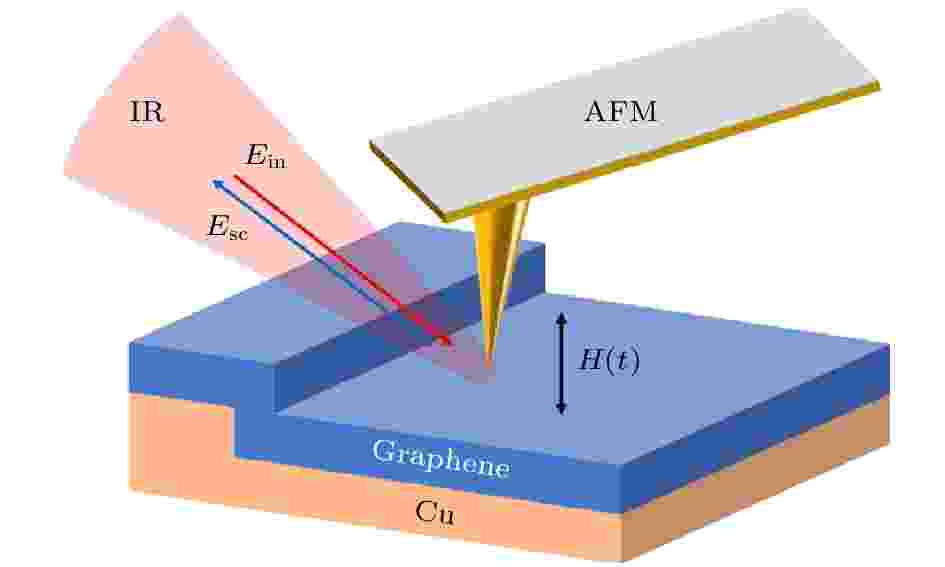
EDITOR'S SUGGESTION
2020, 69 (2): 027803.
doi:10.7498/aps.69.20191598
Abstract +
Graphene plasmons, collective oscillation modes of electrons in graphene, have recently attracted intense attention in both the fundamental researches and the applications because of their strong field confinement, low loss and excellent tunability. The dispersion of graphene plasmons can be significantly modified in the system of graphene on metal substrate, in which the screening of the long-range part of the electron-electron interactions by nearby metal can lead to many novel quantum effects, such as acoustic plasmons, quantum nonlocal effects and renormalization of band structure. Scattering-type scanning near-field optical microscopy (s-SNOM) which consists of a laser coupled to the tip of an atomic force microscopy (AFM), is an effective technique to directly probe plasmons in two-dimensional materials including graphene, and the graphene plasmons can be observed visually by real-space imaging. But so far the detailed s-SNOM studies of graphene/metal system have not been reported. One potential challenge is that the near-field response of highly conductive metal substrate may partially or entirely obscure that of graphene, making it difficult to further explore graphene by using s-SNOM. Here in this paper, we report the direct observation of near-field optical response of graphene in a graphene/metal system excited by a mid-infrared quantum cascade laser. From a close examination of the data of graphene/Cu compared with that of h-BN/Cu, we are able to identify experimental features due to the near-field response of graphene. Surprisingly, two completely different behaviors are observed in the s-SNOM data for different graphene samples on Cu substrates with similar surface step geometries. These results suggest that the near-field response of graphene/metal system is not completely dominated by the metal substrate, and that two completely different near-field response behaviors of graphene may be attributed to their intrinsic properties affected by metal substrates themselves rather than surface step geometries of metal substrate. In addition, following this approach it is possible to distinguish the near-field optical responses of graphene from that of graphene/metal system. Our work reveals the clear signatures of the near-field optical response of graphene on metal substrate, which provides the foundation for probing plasmons in these systems by using the s-SNOM and understanding many novel quantum phenomena therein.
INTERDISCIPLINARY PHYSICS AND RELATED AREAS OF SCIENCE AND TECHNOLOGY
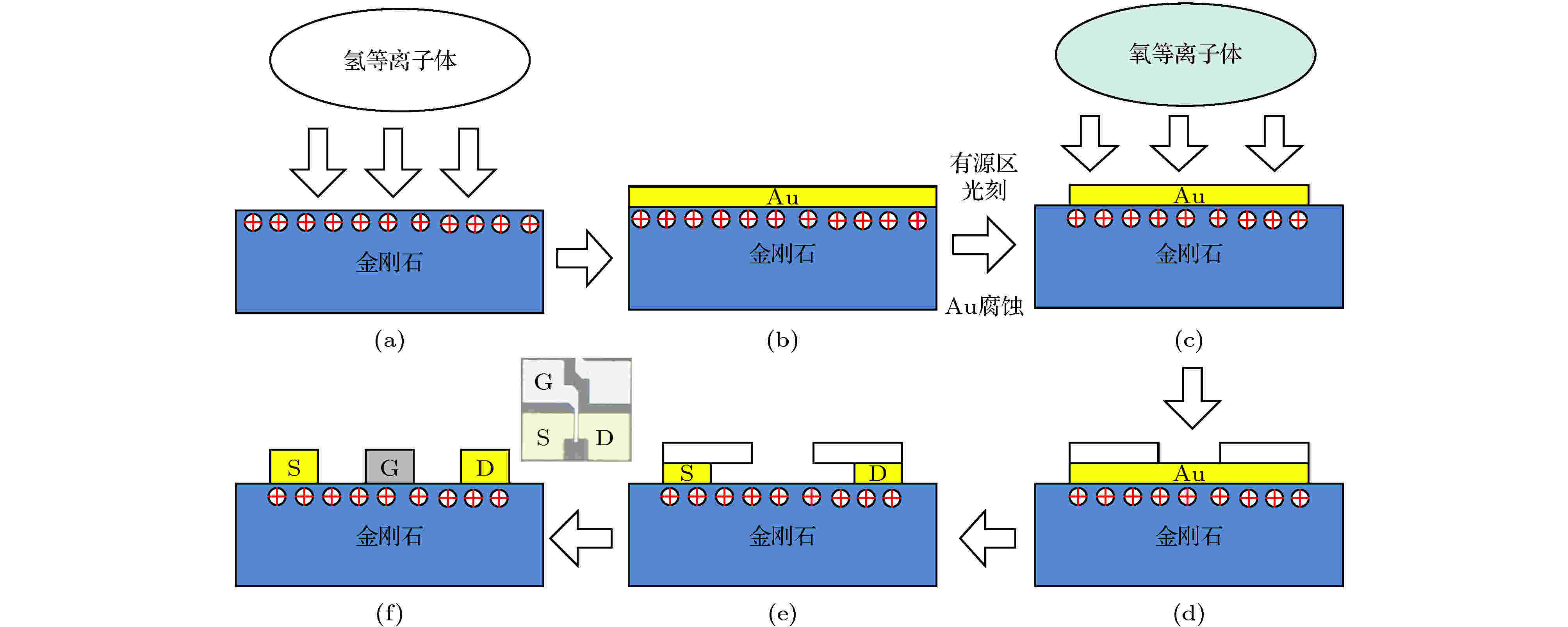
2020, 69 (2): 028101.
doi:10.7498/aps.69.20191013
Abstract +
Diamond has great potential applications in high-power, high-frequency semiconductor devices because of its wide band gap (5.5 eV), high thermal conductivity (22W/(cm·K)), and high carrier mobility (4500 cm2/(V·s) for electron, and 3800 cm2/(V·s) for hole). It has been widely considered as an ultimate semiconductor. From the analysis of our previous work, we find that the output current of field effect transistor based on hydrogen-terminated polycrystalline diamond is usually larger than that based on single crystal diamond, and that the preferential orientations of the polycrystalline diamond are mainly
$ \langle 110\rangle $
and
$ \langle 111\rangle $
shown by XRD results. Therefore, in order to further analyze the effect of surface orientation on the device performance of hydrogen-terminated diamond field effect transistor (FET), we study the devices fabricated respectively on the (110) plane and (111) plane single crystal diamond plates obtained from a single 3.5-mm-thick single crystal diamond grown by the microwave plasma chemical vapor deposition on the high-pressure high-temperature synthesized diamond substrate. Prior to processing the device, these diamond plates are characterized by atomic force microscope, Raman spectra and photoluminescence (PL) spectra. The results of Raman and PL spectra show that (110) plane and (111) plane plates originating from the same CVD single crystal diamond have no significant difference in optical property. Then the normally-on hydrogen-terminated diamond FET with a gate length of 6 μm is achieved. The device on (111) plane delivers a saturation drain current of 80.41 mA/mm at a gate voltageVGS= –4 V, which is approximately 1.4 times that of the device on (110) plane. Meanwhile, the on-resistance of the device on (111) plane is 48.51 Ω·mm, and it is only 67% of the device on (110) plane. Analyses of the capacitance-voltage show that the hole concentration of the gated device on (110) plane and (111) plane are 1.34 × 1013cm–2and 1.45 × 1013cm–2, respectively, approximately at the same level. In addition, the hole density of the device on both (110) and (111) plane increase near-linearly with the increase of gate voltage from the threshold voltage to – 4 V, indicating that the control effect of the gate on the carrier in the channel is uniform. The possible reason for the higher saturation drain current as well as the lower on-resistance of the device on (111) plane is that its sheet resistance is lower.
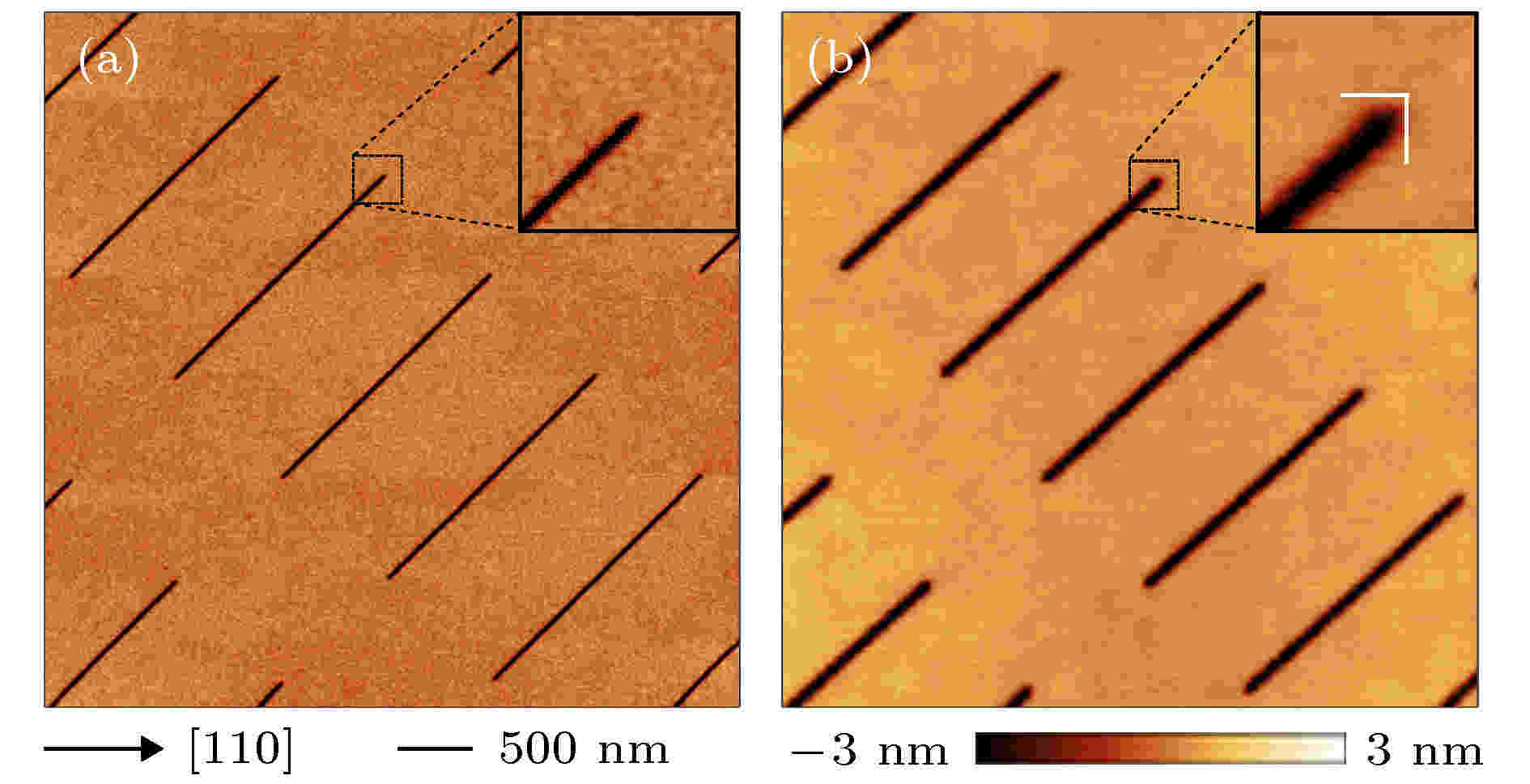
COVER ARTICLE
2020, 69 (2): 028102.
doi:10.7498/aps.69.20191407
Abstract +
Controllable growth of nanowires is a prerequisite for addressability and scalability of nanowire quantum devices. By combining top-down nanofabrication and bottom-up self-assembly, site-controlled GeSi nanowires with two (105) facets can be grown on Si (001) substrate with pre-patterned trenches. Trenches along the [100] or [010] crystallographic direction with 60 nm in width and 6 nm in height are fabricated on Si substrate by electron beam lithography and reactive ion etching. Subsequently, a 60-nm-thick Si buffer layer is grown at 330–400 ℃ on the patterned substrate to improve the surface quality. The facets at the tip of the trenches transform into (11n) after depositing the Si buffer layer. Self-organized GeSi nanowires form inside the trenches by depositing the 6-nm-thick Si67Ge33film at 450 ℃ followed by 1 h annealing at 510 ℃. The GeSi nanowires are (105)-faceted with an average height of approximately 7 nm. Furthermore, we systematically study the influence of annealing temperature, Ge concentration and pattern period on the formation of site-controllable GeSi nanowire on a patterned Si (001) substrate. The GeSi nanowires can be formed only inside the trenches within a specific annealing temperature ranging from 500 ℃ to 520 ℃. It is also discovered that GeSi nanowires are very sensitive to Ge concentration, as they cannot form at lower Ge concentration due to a large nucleation energy barrier. In contrast, high Ge concentration will lead to the discontinuity of nanowires caused by higher atomic diffusion barrier. The generated GeSi nanowires in the trenches exhibit similar dimensions at different pattern periods, which indicates that the growth process is thermodynamically determined. Overall, we realize the controllable growth of the GeSi nanowires, while the length of nanowires can reach the millimeter even centimeter scales, replying on the patterned trench length. The above results offer a controllable growth method of the Ge nanowires, which could potentially lead to the scalability of the Ge quantum devices on Si substrates.
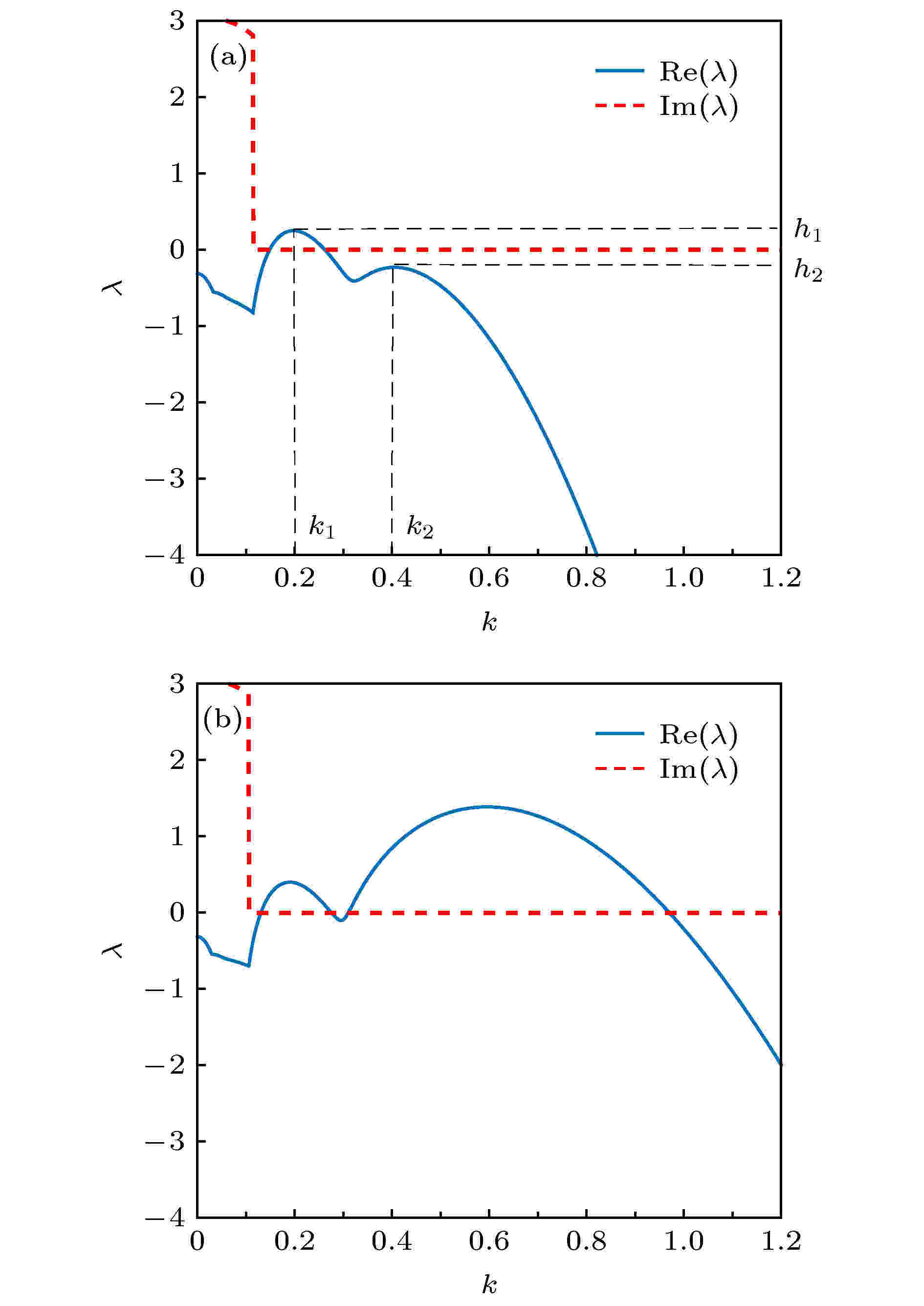
2020, 69 (2): 028201.
doi:10.7498/aps.69.20191353
Abstract +
The coupling mechanism is one of most important approaches to generating multiple-scaled spatial-temporal patterns. In this paper, the mode interaction between two different Turing modes and the pattern forming mechanisms in the non-symmetric reaction diffusion system are numerically investigated by using a two-layered coupled model. This model is comprised of two different reaction diffusion models: the Brusselator model and the Lengyel-Epstein model. It is shown that the system gives rise to superlattice patterns if these two Turing modes satisfy the spatial resonance condition, otherwise the system yields simple patterns or superposition patterns. A suitable wave number ratio and the same symmetry are two necessary conditions for the spatial resonance of Turing modes. The eigenvalues of these two Turing modes can only vary in a certain range in order to make the two sub-system patterns have the same symmetry. Only when the long wave mode becomes the unstable mode, can it modulate the other Turing mode and result in the formation of spatiotemporal patterns with multiple scale. As the wave number ratio increases, the higher-order harmonics of the unstable mode appear, and the sub-system with short wave mode undergoes a transition from the black-eye pattern to the white-eye pattern, and finally to a temporally oscillatory hexagon pattern. It is demonstrated that the resonance between the Turing mode and its higher-order harmonics located in the wave instability region is the dominant mechanism of the formation of this oscillatory hexagon pattern. Moreover, it is found that the coupling strength not only determines the amplitudes of these patterns, but also affects their spatial structures. Two different types of white-eye patterns and a new super-hexagon pattern are obtained as the coupling strength increases. These results can conduce to understanding the complex spatial-temporal behaviors in the coupled reaction diffusion systems.
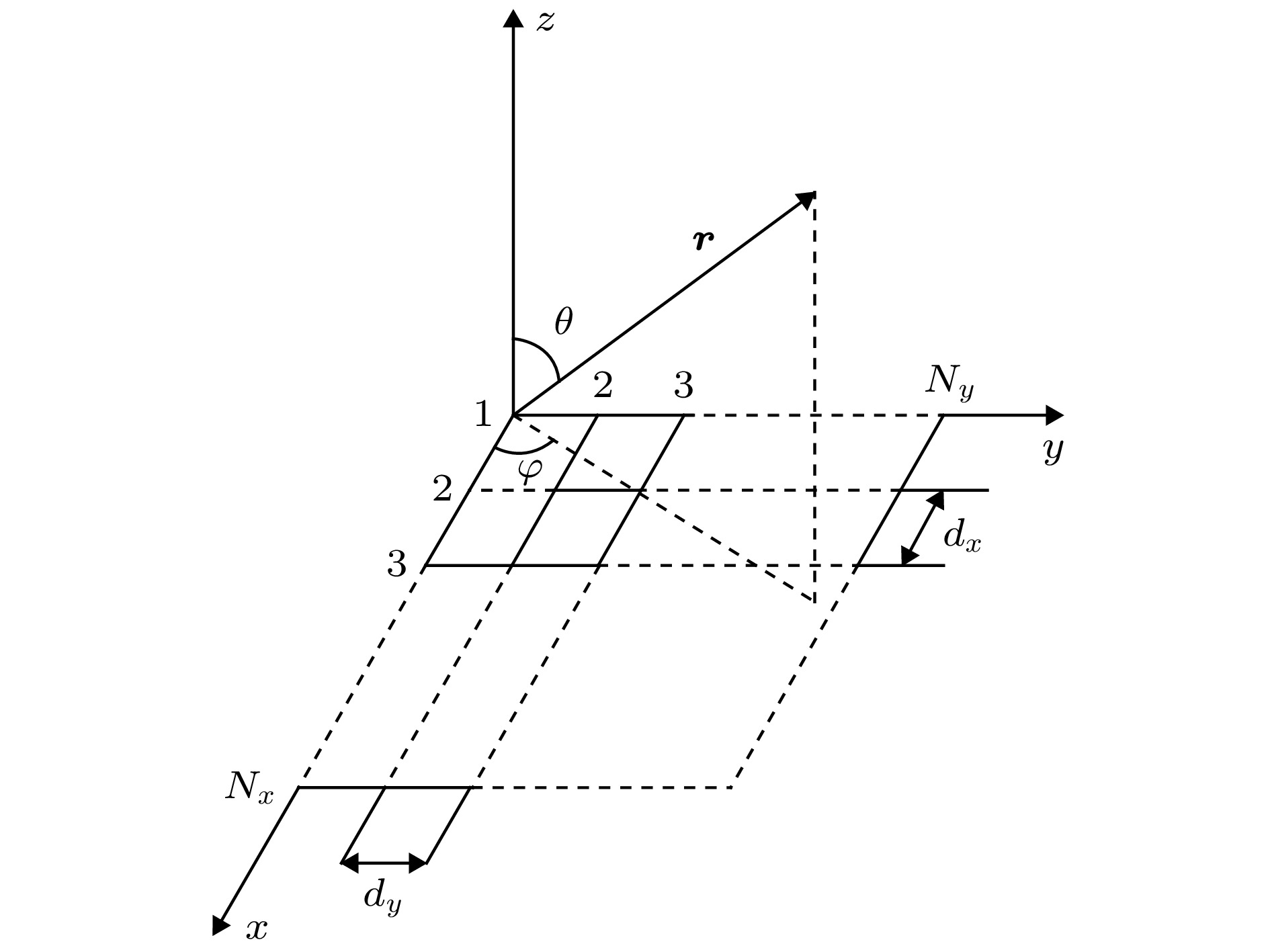
2020, 69 (2): 028401.
doi:10.7498/aps.69.20191268
Abstract +
Directivity is one of the core performance parameters for an antenna, and its accurate computation and measurement have been receiving attention in the past decades. While quite a number of computational methods for antenna directivity are developed, a comprehensive comparison among these methods, including their advantages and disadvantages, has not yet been reported. In the literature, most of these methods can be roughly classified as two categories, i.e. numerical methods and analytical methods. The numerical methods include those simplified numerical methods for accessing the radiation pattern. For example, some methods assume that the radiation pattern is only elevation-angle dependent, and an approximate truncation of the integral interval is often employed. The analytical methods are developed, where the electromagnetic radiation intensity and the total radiation power for a specific antenna are derived analytically. Nevertheless, so far there have been less efforts dedicated to developing general computational methods based on the antenna's planar near-field theory and associated computational schemes, although indeed quite a few of advanced mathematical approaches have been used to obtain the accurate directivity, including the series expansion based on the spherical wave scheme and the Fourier expansion scheme. In spite of these efforts, one can see that a general accurate numerical scheme for the antenna directivity is still urgently required. As an important supplement to these efforts, this paper adopts or proposes four numerical integration methods regarding planar near-field measurement of the antennas under test. Based on the planar near-field theory, microwave near-field data, and fast Fourier transform (FFT), this paper discusses the numerical integration-based algorithm schemes based on the simulated (or measured) near-field data and relevant numerical uncertainty estimation. Specifically, an antenna with accurate directivity is chosen for illustrating the accuracy assessment. First, a set of near-field data under the well-established probing condition is simulated and then used as an input for subsequent numerical calculation of the antenna directivity value. Four different numerical integration methods are employed and their possible numerical errors are discussed. Consequently, the antenna directivity values are obtained respectively from the four different numerical methods. It is revealed that the numerically evaluated directivity values from the near-field data are roughly at most 0.6 dB larger than the accurate value. This work represents a substantial step toward a reliable estimation of the antenna directivity from the near-field data of an antenna.
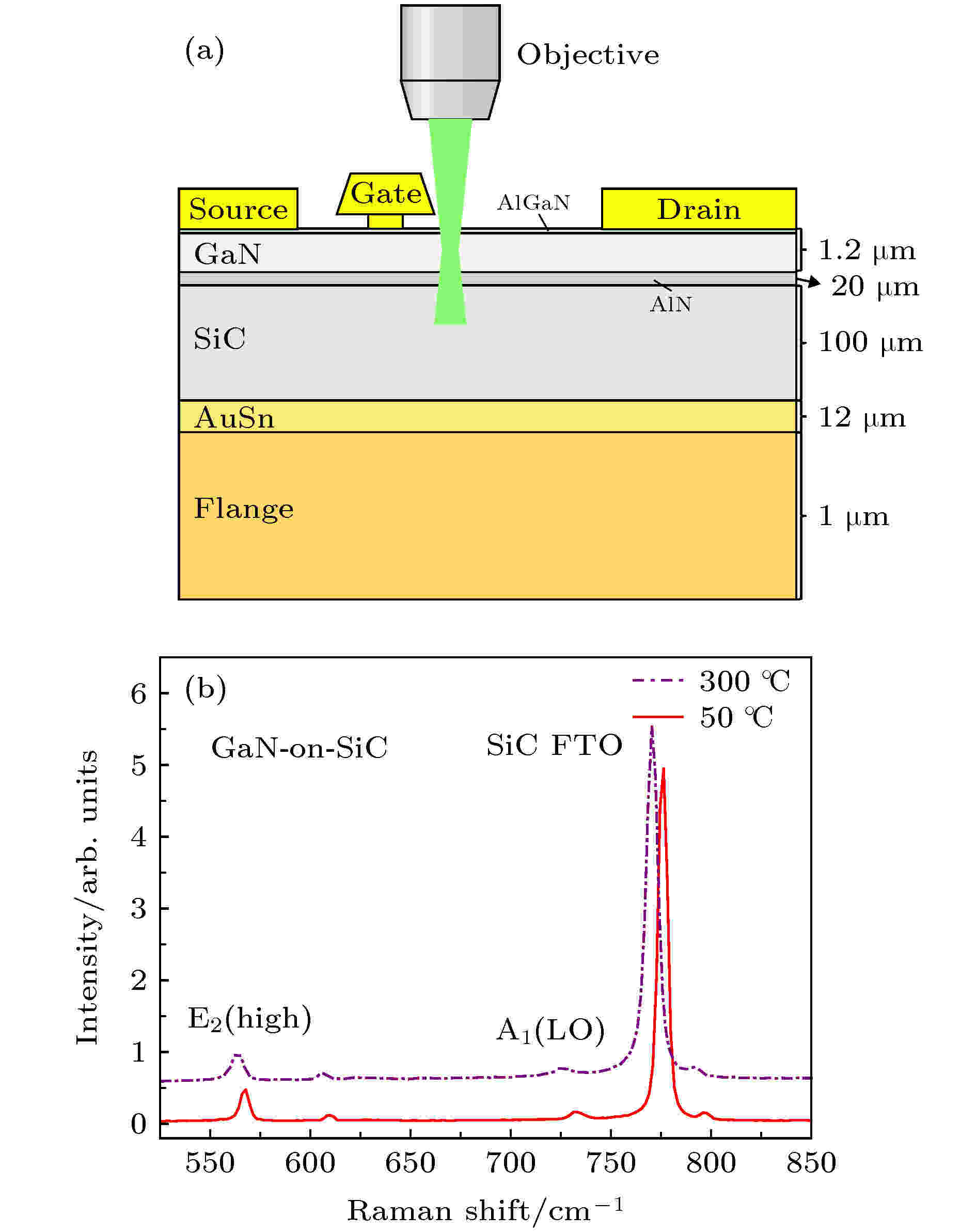
2020, 69 (2): 028501.
doi:10.7498/aps.69.20190921
Abstract +
The electrical performance and the long-term reliability of GaN-based high electron mobility transistors (HEMTs) are greatly affected by the Joule self-heating effect under high power density operation condition. Measurement of the junction temperature and analysis of the thermal resistance of the constituent layers including the packaging material are critically important for thermal design and reliability assessment of GaN-based HEMTs. In this paper, Raman thermometry combined with the finite element thermal simulation is used to compare the junction temperature and the thermal resistance of a GaN HEMT mounted on a novel Cu/graphite composite flange with those of a conventional CuMo flanged device. The results show that the junction temperature of the Cu/graphite flanged device is 15% lower than that of the CuMo flanged device at a power dissipation of 1.43 W/mm, while the overall device thermal resistance is 18.7% lower in the Cu/graphite flanged device. In addition, the temperature distributions of each layer along the cross-plane direction are analyzed for the two devices; the thermal resistance ratio of the Cu/graphite flange is 40% of the overall device thermal resistance, while the CuMo flange account for 53% of the overall thermal resistance of the device. This proves the effectiveness and benefit of using the Cu/graphite composite material package of high thermal conductivity to improve the heat dissipation of GaN HEMTs. By tuning the mass fraction of the graphite, it is possible to further increase the thermal conductivity of the Cu/graphite composite flange and to further reduce the device thermal resistance. It is observed in the Raman thermal measurement that the highest thermal resistance after flanging is the interfacial thermal resistance between the GaN epitaxial layer and the SiC substrate (~50 m2·K/GW). For obtaining the better thermal characteristics of the GaN HEMT, it is crucial to reduce the GaN/SiC interfacial thermal resistance through interface engineering during the epitaxial growth. In the meantime, Raman thermometry combined with the finite element thermal simulation is demonstrated to be an effective method for implementing the thermal characterization of the GaN-based devices and the constituent material layers, and the principle and procedure of the method are described in detail in the paper.
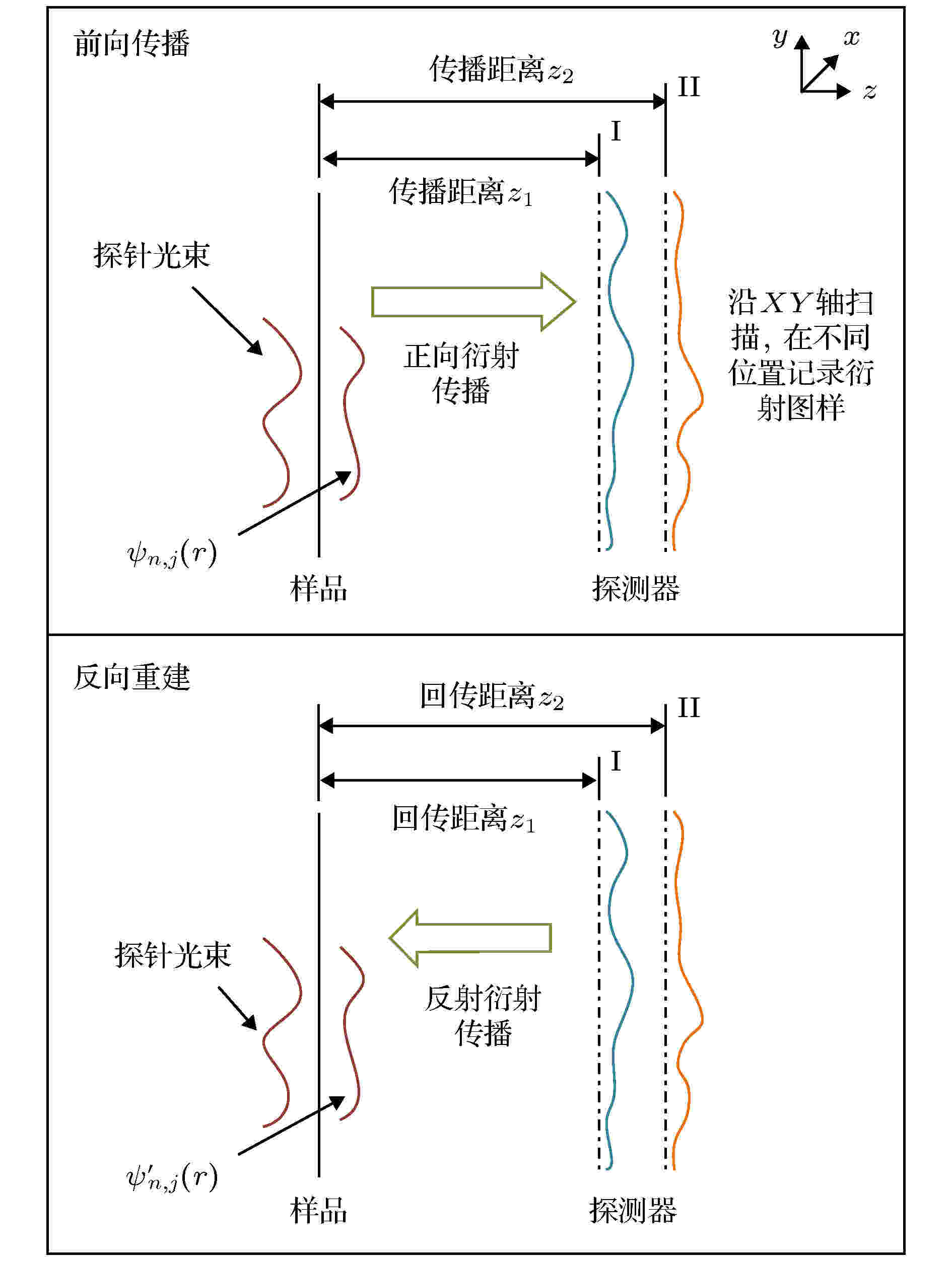
2020, 69 (2): 028701.
doi:10.7498/aps.69.20191310
Abstract +
Terahertz (THz) radiation lies between the millimeter and infrared region of the electromagnetic spectrum, which is typically defined as the frequency range of 0.1–10 THz and the corresponding wavelength ranges from 30 μm to 3 mm. Terahertz radiation due to wide spectrum, high penetration, low energy, and other important features, has been a valuable tool for imaging and non-destructive testing on a submillimeter scale. Continuous-wave (CW) terahertz ptychography is a type of phase-contrast technique with advantages of simple set-up and large field-of-view. It retrieves the complex-valued transmission function of the specimen and the probe function at the same time. The extended ptychographic iterative engine (ePIE) algorithm is used as the reconstruction algorithm in the field of ptychography, because it is relatively simple, and can use computer memory efficiently. However, the problem of algorithm convergence delay makes us unable to acquire the reconstruction result very quickly. Since the ptychography is a problem of retrieving phase information, physical constraints affect the convergence speed of the algorithm strongly. In this paper, we propose a dual-plane ePIE (dp-ePIE) algorithm for CW THz ptychography. By moving detector along the axis and capturing diffraction patterns of one zone of an object at two recording planes, then, two sets of patterns used as the constraints simultaneously can increase the diversity of experimental parameter. Hence, the convergence rate can be improved. The simulation results suggest better reconstruction fidelity with a faster convergence rate by the dp-ePIE algorithm. The dual-plane terahertz ptychography experimental setup is built based on 2.52 THz optically pumped laser and Pyrocam-III pyroelectric array detector. Compared with other methods to increase the diversity of measurement, the setup of dual-plane ptychography can be compact and simple, thus reducing the terahertz wave transmission loss. A polypropylene sample is adopted and it is approximated as a pure phase object. No-reference structural sharpness (NRSS) is utilized as a quantitative evaluation index. It takes 45.086 s to achieve NRSS value of 0.9831 by using the dp-ePIE algorithm in 10 iterations, while the NRSS value and calculation time for e-PIE algorithm are 0.9531 and 57.117 s (20 loops), respectively. The experimental results show that the dp-ePIE algorithm can obtain high-quality amplitude and phase distribution with less iterations than the traditional ePIE algorithm.
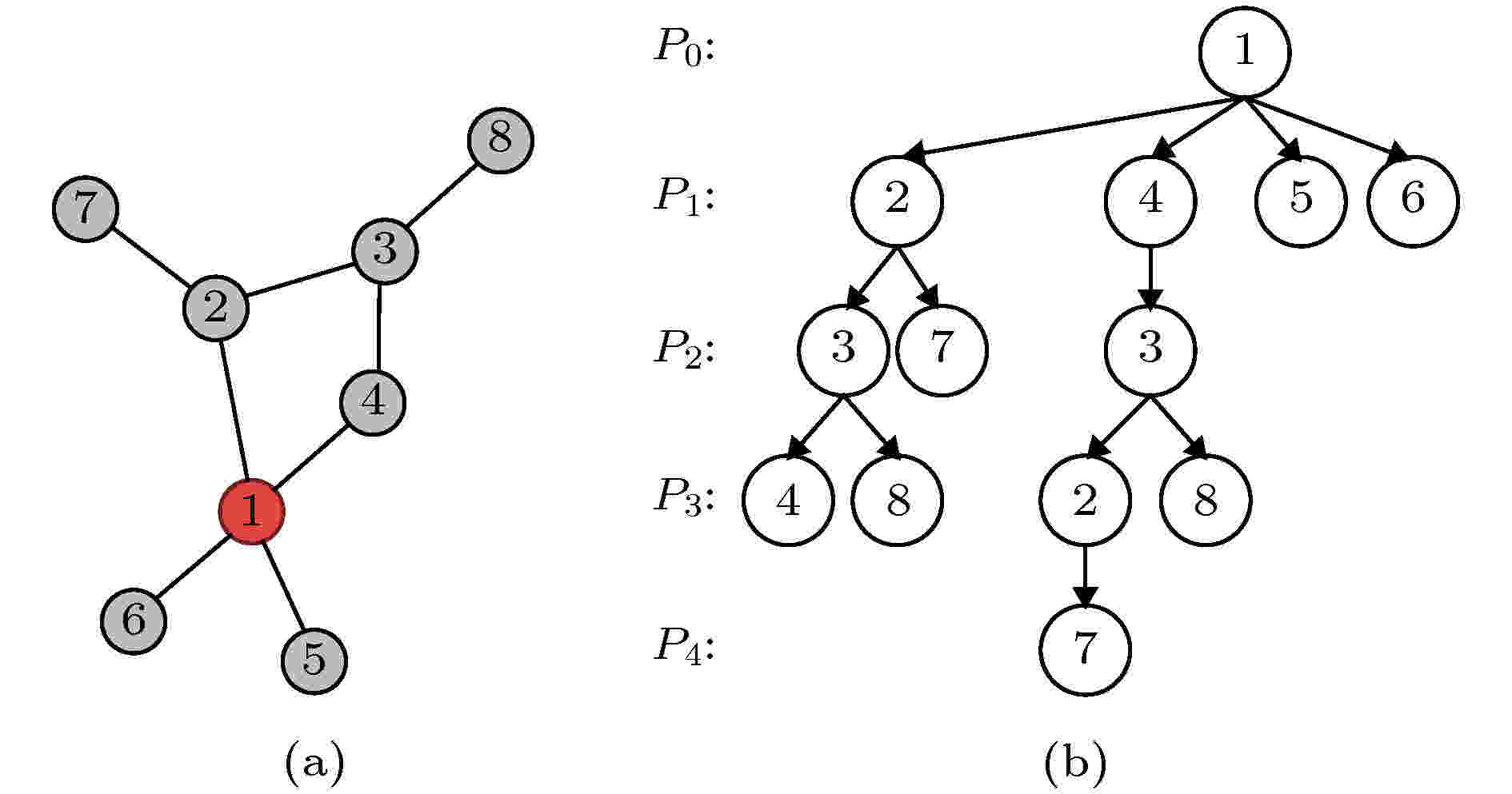
2020, 69 (2): 028901.
doi:10.7498/aps.69.20191313
Abstract +
On-line social networks have gradually become an indispensable tool for people. Identifying nodes with high influence in the network as an initial source of communication is of great significance in social perception and rumor control. According to the independent cascade model, in this paper we present an index describing the finite step propagation range expectation as the degree of propagation, and design an efficient recursive algorithm. Based on the local topology information, the index combines the propagation probability to characterize the influence, which can better reflect the propagation influence of a single node. For a single propagation source influence ordering problem, the node degree of propagation and propagation capability are better consistent with each other. And the propagation degree can well describe the propagation influence of nodes under different networks and propagation probabilities. For maximizing the multi-propagation source influence, in this paper we propose a propagation-based heuristic algorithm which is called propagation discount algorithm. This algorithm makes the joint influence of multiple propagation sources maximized. Finally, in this paper we apply the above method to three real networks, showing better effects than the classic indicators and methods. The algorithm has three advantages. First, the expected value of the final propagation range of each node in the small network can be accurately calculated. Second, the degree of propagation fully considers the local topology of the node and belongs to a locality indicator. Third, the indicator combines the effect of propagation probability and yields good outcomes under different networks and propagation probabilities.
GEOPHYSICS, ASTRONOMY, AND ASTROPHYSICS
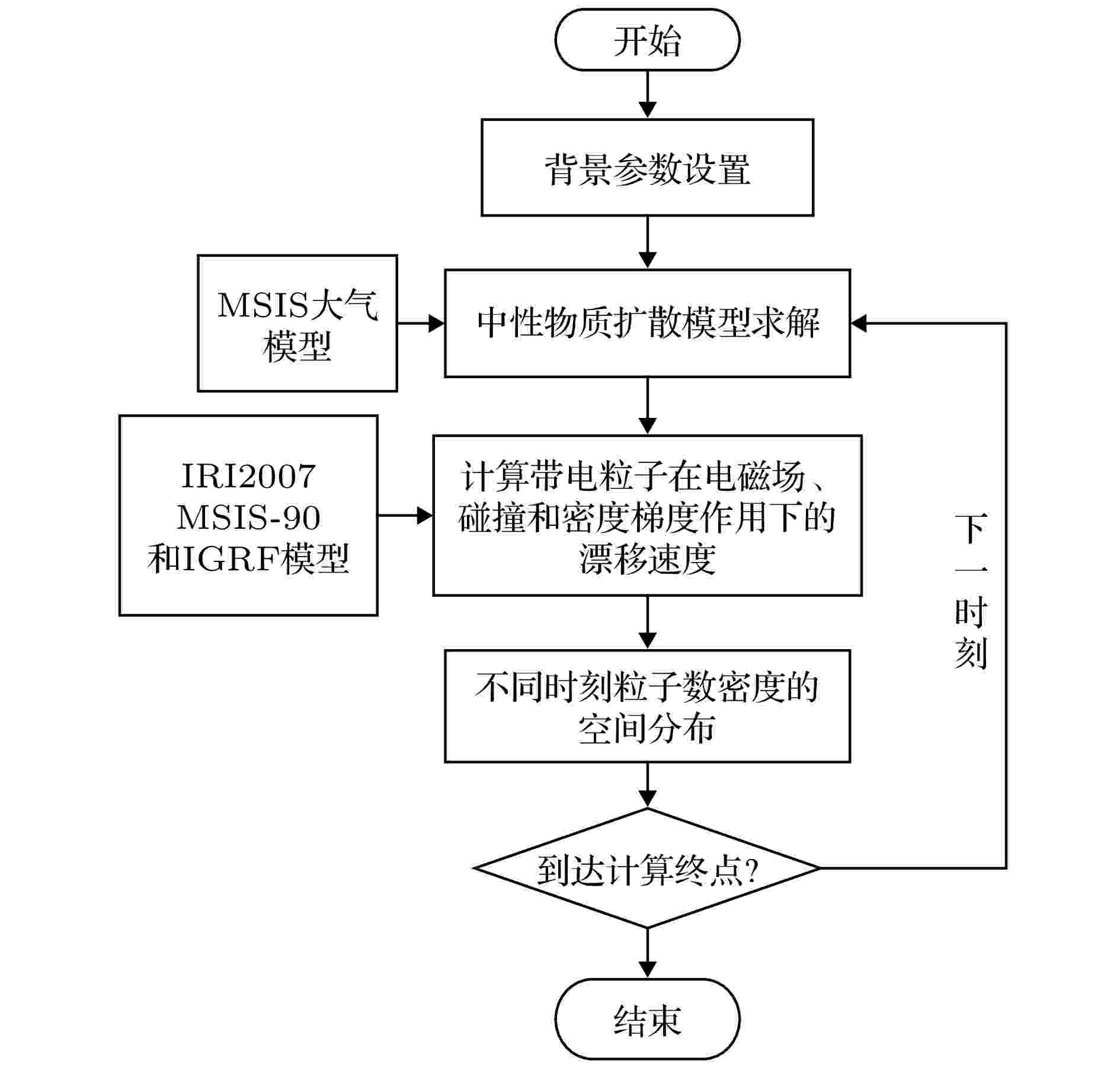
2020, 69 (2): 029401.
doi:10.7498/aps.69.20191266
Abstract +
After being released in the ionosphere, alkali-metal atoms will be rapidly photoionized by solar UV, producing positive ions and electrons, and forming artificial plasma cloud. Based on a three-dimensional two-species fluid model, considering both the loss of barium atoms due to photoionization and oxidation and the influence of horizontal wind field in the release region, the spatial-temporal evolution of the artificial plasma cloud is discussed. By taking into account the electromagnetic field force, pressure gradient, particle collisions and ion inertia, the ionospheric disturbance effects caused by barium and cesium are compared with each other. The simulation results show that the alkali metal rapidly expands after being released in the ionosphere, and the generated plasma cloud gradually forms an ellipsoidal structure from the inside to the outside under the constraint of magnetic field with considering no wind. Meanwhile, the expanded plasma cloud pushes away the background oxygen ions, forming an oxygen ion density hole in the release center and two symmetrical density bumps on both sides. In the absence of neutral wind, the plasma cloud is dominated by the movement along magnetic field, while considering the background neutral wind, the plasma cloud and background disturbance area will move along the direction of wind, so that the density gradient of plasma cloud becomes steepening on the upwind side. Although the movement of ion cloud across the magnetic field is constrained, the neutrals can pass through the magnetic field freely, so the ion cloud and neutral cloud will separate from each other slowly. Also, the presence of horizontal wind field will make a greater disturbance to the background oxygen ion. By comparing the simulation results of barium and cesium we can see that, qualitatively, the expansion characteristics of Cs+and Ba+as well as their effects on the background O+are similar. Due to the small diffusion coefficient of cesium, the barium cloud expands more rapidly and the coverage area of Ba+cloud is wider. Because of the large photoionization rate of cesium, the ionization yield of cesium is higher than that of barium when the same mass is released. In addition, the snowplow effect of Cs+is stronger than that of Ba+, and the oxygen ion density holes and bumps caused by Cs+are also larger.
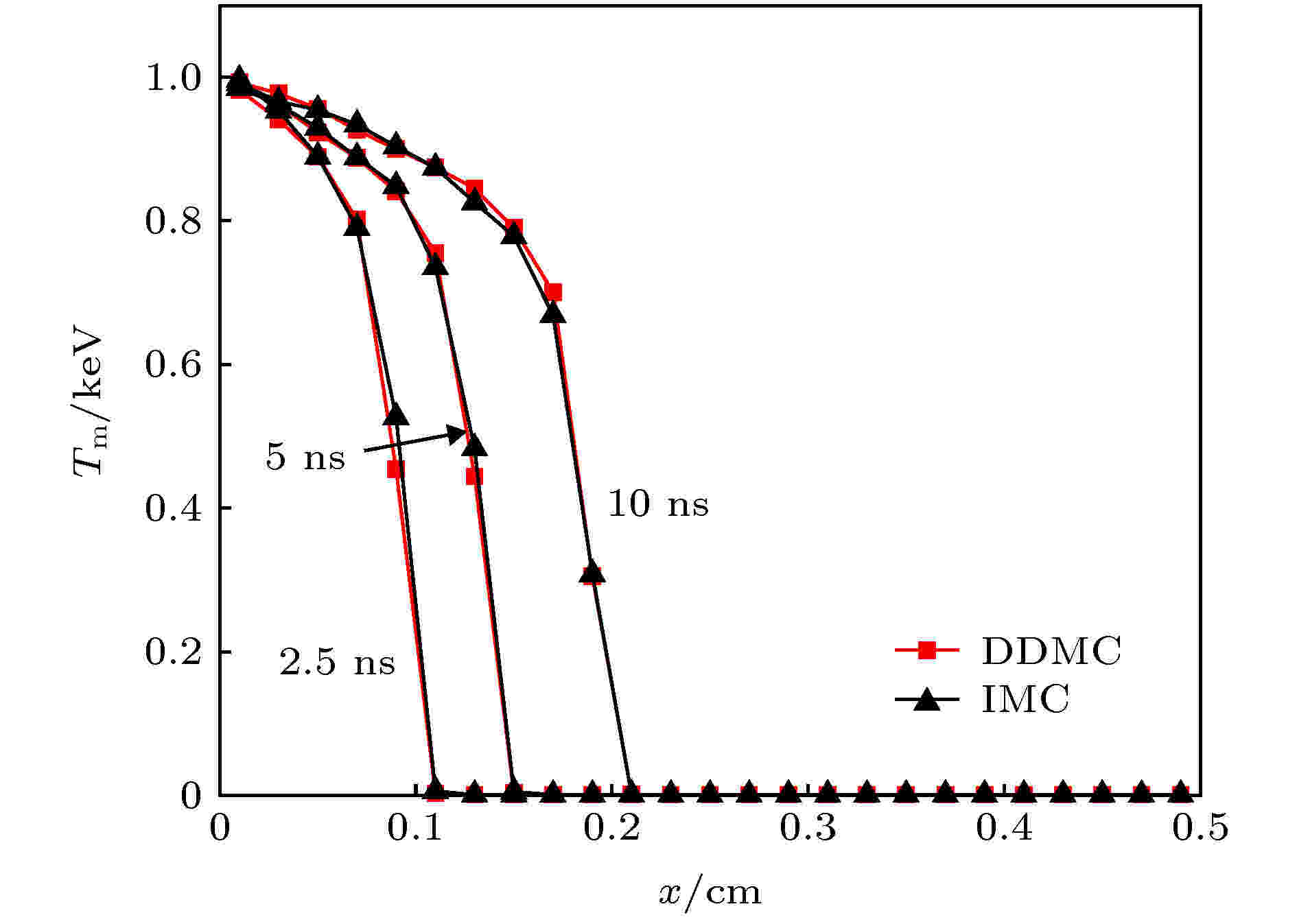
2020, 69 (2): 029501.
doi:10.7498/aps.69.20191315
Abstract +
Thermal radiation transfer in material and the interaction between radiative photon and material are important research projects of the inertial confinement fusion, and Monte Carlo method is one of the important researching methods. Based on the implicit integral-differential transport equation, traditional implicit Monte Carlo method can accurately simulate the thermal radiation transport in material. However, the implicit Monte Carlo method would take quite a long computational time when the opacity is increased because scattering events are dominant in particles’ histories, thus reducing the simulation efficiency. In this paper, based on discrete diffusion Monte Carlo method, i.e. a radiation transport code, the discrete diffusion Monte Carlo radiation transport simulation, is developed. The code increases the efficiency of thermal radiation simulations in a high opacity range, but it can yield insufficiently accurate results in a low opacity range. There exist low opacity material and high opacity material in the inertial confinement fusion. In this work, investigated are several numerical techniques that can improve the utility and accuracy of discrete diffusion Monte Carlo for grey thermal radiation simulation. First, the discrete diffusion Monte Carlo method and implicit Monte Carlo method are combined. Second, a new method of treating the interface between the diffusive region and the transport region is proposed. Finally, a hybrid radiative transfer program is developed. In order to verify the hybrid radiative transfer program and the new interface method, a series of numerical experiments for typical thermal radiation transport problem is conducted. In these problems, materials with different opacities are tested. Then the simulation efficiencies and curves of temperature, obtained by the two Monte Carlo methods, are analyzed. According to the simulation results, the program can not only accurately simulate the radiation transport in material with high opacity, but also remarkably increase the simulation efficiency. This is because many implicit Monte Carlo steps are substituted by one diffusive step and the details in the diffusive step are ignored. Also, the propagation of thermal radiation depicted with figures and tables are consistent with the radiation transport theory. In addition, the results from the hybrid Monte Carlo method reach the same accuracy as that from the implicit Monte Carlo method, and the simulation efficiency is remarkably increased.
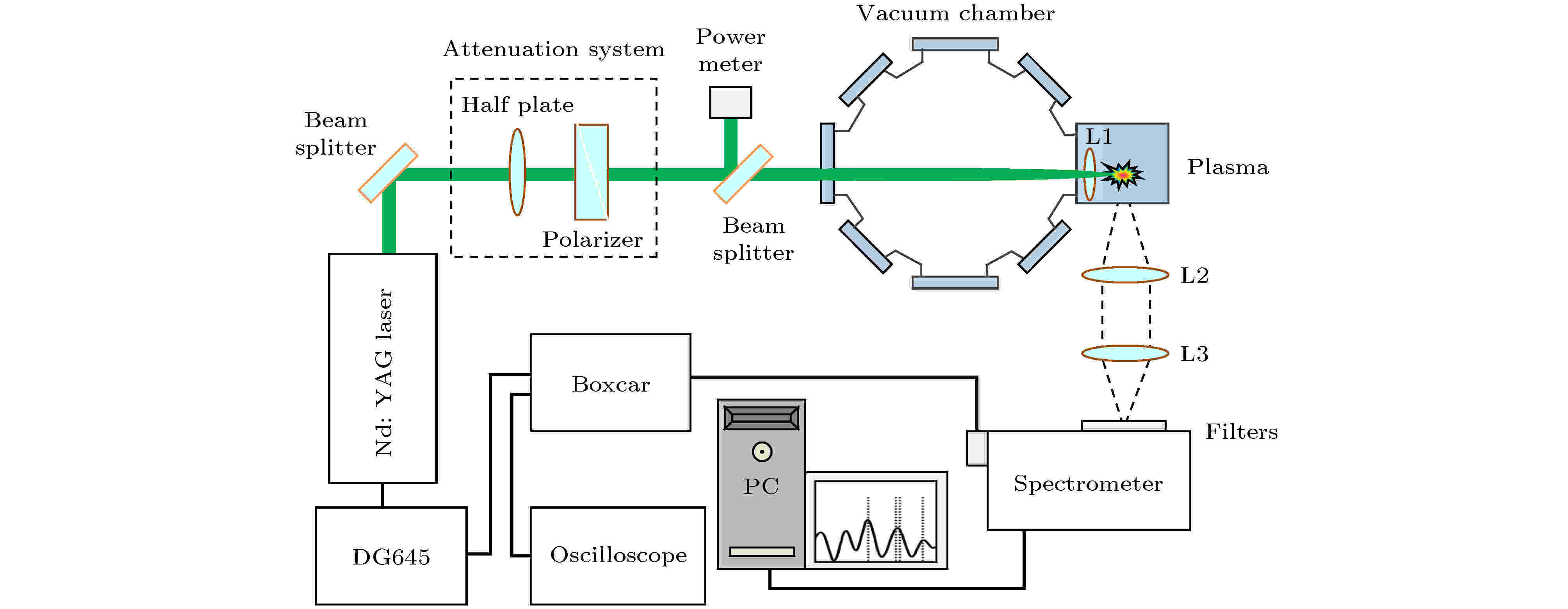
2020, 69 (2): 029502.
doi:10.7498/aps.69.20190753
Abstract +
The near infrared emission from laser induced air plasma has been investigated in a range of 1100–2400 nm. The infrared spectra of air plasma consist of linear spectral and continuum radiation. Most of the spectral features observed are identified, including atomic lines of O I and N I and molecular bands of N2. The spectra show trace of blackbody background emission and the plasma temperature is estimated from Planck law. We find that the continuum radiation is mainly origins mainly from the blackbody emission of plasma. There is a limitation of plasma temperature estimation by using Boltzmann method. For example, the local thermodynamic equilibrium must be satisfied, and the trend of change in plasma temperature can be estimated within a few microseconds after the laser shot. In this paper, the plasma temperature in 15 μs after laser irradiation is estimated from the Planck law, and the temperature of air plasma is estimated to be about 3900 K, which can compensate for the shortcomings of Boltzmann method. It is found that the neutral atomic spectra of N and O both may contribute to the radiation of the air plasma at 1128 nm. Then we keep the air pressure in the vacuum chamber at 80 kPa, and change the nitrogen and oxygen content in the chamber. The infrared spectrum data show that the oxygen content in the mixed gas only affect the radiation of 1128 nm wavelength. The binary linear regression analysis shows that oxygen contributes much to the radiation of 1128 nm wavelength. This can be explained by the difference in ionization potential between molecule O2and N2. The infrared radiation intensities of the air plasma at 1128 nm under 20−80 kPa are obtained, and they are compared with the calculated results obtained with the fitting formula. The predicted value is very close to the experimental value and the relative error is negligibly at the pressure of 30−80 kPa. The study of the characteristics of infrared emission from laser induced plasma is of great significance for understanding and using the physical mechanisms of laser-matter interaction.











